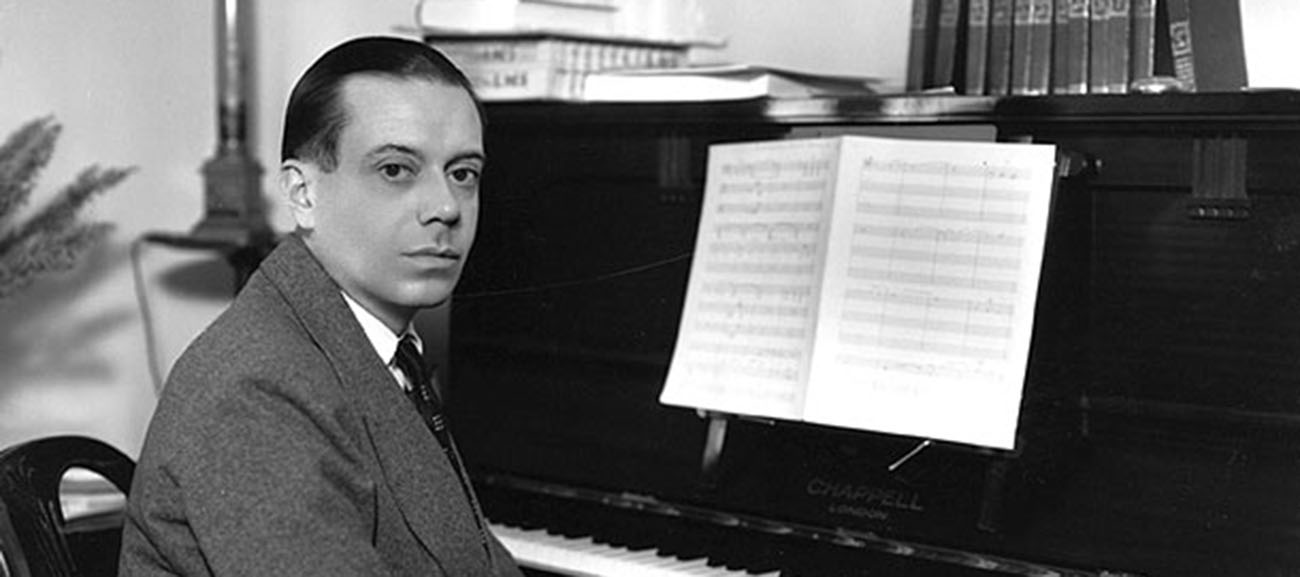
C) Cole Porter (6/6) (suite)
C.11) Quelques oeuvres de Cole Porter en bref
001 - Cora - Musical (Oeuvre scolaire)
Création: 1911 11 28 - 1 représ. - Phi Theatre (New Haven - Etats-Unis)
002 - And the Villain Still Pursued Her - Musical (Oeuvre scolaire)
Création: 1912 4 24 - 1 représ. - New Haven Lawn Club (New Haven - Etats-Unis)
003 - Pot of Gold (The) - Musical (Oeuvre scolaire)
Création: 1912 11 26 - 1 représ. - Delta Kappa Epsilon fraternity house (New Haven - Etats-Unis)
004 - Kaleidoscope (The) - Musical (Oeuvre scolaire)
Création: 1913 4 30 - 1 représ. - Hotel Taft (New Haven - Etats-Unis)
005 - Paranoia - Musical (Oeuvre scolaire)
Création: 1914 4 24 - 1 représ. - Hotel Taft (New Haven - Etats-Unis)
006 - Hands Up - Revue
Création: 1915 7 22 - représ. - 44th Street Theatre (Broadway - Etats-Unis)
007 - Miss Information - Musical
Création: 1915 10 5 - 47 représ. - George M. Cohan's Theatre (Broadway - Etats-Unis)
008 - See America First - Musical
Création: 1916 3 28 - 15 représ. - Maxine Elliott's Theatre (Broadway - Etats-Unis)
009 - Hitchy-Koo of 1919 - Revue
Création: 1919 10 6 - 56 représ. - Liberty Theatre (Broadway - Etats-Unis)
010 - A Night Out - Musical
Création: 1920 9 18 - 309 représ. - Winter Garden Theatre (Londres - Angleterre)
011 - Mayfair and Montmartre - Revue
Création: 1922 3 9 - 77 représ. - Oxford Music Hall (Londres - Angleterre)
012 - Hitchy-Koo of 1922 - Revue
Création: 1922 10 10 - 15 représ. - Shubert Theatre (Philadelphia - Etats-Unis)
013 - Within the Quota - Danse
Création: 1923 10 25 - représ. - Théâtre des Champs-Elysées (Paris - France)
014 - Greenwich Village Follies of 1924 (The) - Revue
Création: 1924 9 16 - 127 représ. - Shubert Theatre (Broadway - Etats-Unis)
015 - Revue des Ambassadeurs (La) - Revue
Création: 1928 5 10 - représ. - Café des Ambassadeurs (Paris - France)
016 - Paris - Musical
Création: 1928 10 8 - 195 représ. - Music Box Theatre (Broadway - Etats-Unis)
017 - Wake Up and Dream - Revue
Création: 1929 3 5 - 263 représ. - London Pavilion (Londres - Angleterre)
018 - Fifty Million Frenchmen - Musical
Création: 1929 11 27 - 254 représ. - Lyric Theatre (Broadway - Etats-Unis)
019 - Battle of Paris (The) - Film
Création: 1929 11 30 - représ. - *** Film (*** - ***)
020 - Vanderbilt Revue (The) - Revue
Création: 1930 11 5 - 13 représ. - Vanderbilt Theatre (Broadway - Etats-Unis)
021 - New Yorkers (The) - Musical
Création: 1930 12 8 - 168 représ. - Broadway Theatre (Broadway - Etats-Unis)
022 - Star Dust - Musical
Création: 1931 - 0 représ. - * Jamais ouvert ( - )
023 - Gay Divorce - Musical
Création: 1932 11 29 - 248 représ. - Ethel Barrymore Theatre (Broadway - Etats-Unis)
024 - Ever Yours - Musical
Création: 1933 - représ. - * Jamais ouvert ( - )
025 - Nymph Errant - Musical
Création: 1933 10 6 - représ. - Adelphi Theatre (Londres - Angleterre)
026 - Anything goes - Musical
Création: 1934 11 21 - représ. - Neil Simon Theatre (Broadway - Etats-Unis)
027 - Jubilee - Musical
Création: 1935 10 12 - 169 représ. - Imperial Theatre (Broadway - Etats-Unis)
028 - Red Hot and Blue - Musical
Création: 1936 10 29 - 183 représ. - Neil Simon Theatre (Broadway - Etats-Unis)
029 - Born to Dance - Film
Création: 1936 11 27 - représ. - *** Film (*** - ***)
030 - Rosalie (film) - Film
Création: 1937 12 24 - représ. - *** Film (*** - ***)
031 - You Never Know - Musical
Création: 1938 9 21 - 78 représ. - Winter Garden Theatre (Broadway - Etats-Unis)
032 - Leave It to Me! - Musical
Création: 1938 11 9 - 291 représ. - Imperial Theatre (Broadway - Etats-Unis)
033 - Du Barry Was a Lady - Musical
Création: 1939 12 6 - représ. - Richard Rodgers Theatre (Broadway - Etats-Unis)
034 - Panama Hattie - Musical
Création: 1940 10 30 - 501 représ. - Richard Rodgers Theatre (Broadway - Etats-Unis)
035 - Let's Face It - Musical
Création: 1941 10 29 - 547 représ. - Imperial Theatre (Broadway - Etats-Unis)
036 - Something for the Boys - Musical
Création: 1943 1 7 - 422 représ. - Neil Simon Theatre (Broadway - Etats-Unis)
037 - Seven Lively Arts - Revue
Création: 1944 12 7 - 183 représ. - Ziegfield Theatre (Broadway - Etats-Unis)
038 - Around the World - Musical
Création: 1946 5 31 - 75 représ. - Adelphi Theatre (Broadway - Etats-Unis)
039 - Kiss me Kate - Musical
Création: 1948 12 30 - 1077 représ. - New Century Theatre (Broadway - Etats-Unis)
040 - Can-Can - Musical
Création: 1953 5 7 - représ. - Shubert Theatre (Broadway - Etats-Unis)
041 - Silk Stockings - Musical
Création: 1955 2 24 - 478 représ. - Imperial Theatre (Broadway - Etats-Unis)
042 - Aladdin (Porter) - Musical
Création: 1958 2 21 - 1 représ. - *** TV (*** - ***)
043 - Cole - Musical
Création: 1974 7 2 - représ. - Mermaid Theatre (Londres - Angleterre)
044 - At Long Last Love - Film
Création: 1975 3 1 - représ. - *** Film (*** - ***)
045 - Happy New Year - Musical
Création: 1980 4 27 - 25 représ. - Morosco Theatre (Broadway - Etats-Unis)
046 - High Society - Musical
Création: 1987 2 25 - représ. - Victoria Palace Theatre (Londres - Angleterre)
047 - A Swell Party - Musical
Création: 1991 10 3 - représ. - Vaudeville Theatre (Londres - Angleterre)
C.12) En détail

Musical (Oeuvre scolaire)
Musique: Cole Porter • Paroles: Cole Porter • Livret: Theodore Gaillard Thomas • Production originale: 1 version mentionnée
Dispo: Génèse Liste chansons
Cole Porter a été le premier musical écrit et produit par Cole Porter alors qu’il était étudiant de premier cycle à l’Université Yale. Il a composé les chansons et joué dans la production, qui a été mise en scène au Phi Theatre de New Haven par la Phi Opera Company.
Genèse: La première a eu lieu le 28 novembre 1911 et le spectacle a été le succès de la saison. Porter était connu dans toute la communauté de Yale comme un leader de tous les événements musicaux et théâtraux, et comme un terrible cabotin sur scène. Ses talents musicaux et théâtraux ravissaient tous ceux qui venaient l’entendre ou le voir. Mais son énorme succès dans ce spectacle, son propre spectacle, n’a pas été le lancement vers la gloire qu’il espérait, bien que certaines des chansons du spectacle aient été retravaillées et réutilisées par la suite. Parmi les plus grands succès, citons les chansons « Le Rêve d’Absinthe », « Concentration » et « My Hometown Girl ».
Principales versions:
1. Phi Theatre (New Haven-Etats-Unis)
28/11/1911 28/11/1911
1 représ.

Musical (Oeuvre scolaire)
Musique: Cole Porter • Paroles: Cole Porter • Livret: Theodore Gaillard Thomas • Production originale: 2 versions mentionnées
Dispo: Génèse Liste chansons
Après le succès de Cora, le premier musical de Cole Porter, il compose la musique d’un deuxième spectacle, produit cette fois par le Yale Dramat. Intitulé And the Villain Still Pursues Her, il s’agissait d’une parodie hilarante du classique américain, La Case de l’oncle Tom. Porter a aidé à la mise en scène et Monty Woolley a joué le rôle du méchant. Il met en évidence le côté maléfique et le livret est plein d’humour, avec des chansons telles que « I’m the Villain », dans laquelle le protagoniste se vante audacieusement d’avoir mis du poison dans la crème de sa mère. Parmi les autres succès, citons « The Lovely Heroine » et « Silver Moon ».
Genèse: La première du spectacle a eu lieu à New Haven à la Yale Dramatic Association le 24 avril 1912. Il a ensuite été transféré au Yale Club de New York le 10 mai.
Principales versions:
1. Yale Dramatic Association (New Haven-Etats-Unis)
24/04/1912 24/04/1912
1 représ.
2. Yale Club (New-York-Etats-Unis)
10/05/1912 10/05/1912
1 représ.

Musical (Oeuvre scolaire)
Musique: Cole Porter • Paroles: Cole Porter • Livret: Almet F. Jenks • Production originale: 2 versions mentionnées
Dispo: Génèse Liste chansons
Cole Porter a écrit The Pot of Gold en collaboration avec le librettiste de Yale, Almet Jenks, qui, en tant qu’étudiant de premier cycle, avait reçu le prix de la meilleure pièce par le Yale Dramat.
Genèse: Le spectacle a été composé comme un événement pour l’ouverture de la pour la fraternité Delta Kappa Epsilon et a été joué à la maison Delta Kappa Epsilon le 4 décembre 1912. Cole Porter a composé les chansons, aidé à la mise en scène et joué dans la production. Figure connue du théâtre musical dans toute la communauté de Yale à ce moment-là, l’apparition de Porter a été accueillie avec enthousiasme. Bien qu’il ne s’agisse que de l’œuvre d’un étudiant de premier cycle, les paroles et la musique montrent des signes du style émergent de Porter. Suaves et sophistiquées avec leur propre marque distinctive d’humour racé, les chansons incluent « We Are So Aesthetic », « It’s Awfully Hard When Mother’s Not Along » et le sentimental « I Love You So ».
Principales versions:
1. Delta Kappa Epsilon fraternity house (New Haven-Etats-Unis)
26/11/1912 26/11/1912
1 représ.
2. Hotel Taft (New Haven-Etats-Unis)
04/12/1912 04/12/1912
1 représ.

Musical (Oeuvre scolaire)
Musique: Cole Porter • Paroles: Cole Porter • Livret: Production originale: 2 versions mentionnées
Dispo: Génèse Liste chansons
Le Kaléidoscope est une comédie musicale en deux actes produite par l’Association dramatique de l’Université de Yale et mise en scène à l’hôtel Taft de New Haven. La musique et les paroles ont été écrites par Cole Porter et le spectacle mettait en vedette Newbold Noyes, Rufus King et le poète Archibald MacLeish
Genèse: La soirée d’ouverture a eu lieu le 30 avril 1913 et a été un grand succès. Bien que la plupart des chansons aient été perdues, les critiques ont annoncé que Porter était un génie en tant que parolier, auteur-compositeur et comédien. Parmi les chansons, citons « We’re a Group of Nonentities », « The Absinthe Drip » et « Oh, What a Pretty Pair of Lovers », qui survit toujours et était un hommage sérieux à deux des amis de Porter.
Principales versions:
1. Hotel Taft (New Haven-Etats-Unis)
30/04/1913 30/04/1913
1 représ.
2. Yale Club (New-York-Etats-Unis)
07/05/1913 07/05/1913
1 représ.

Musical (Oeuvre scolaire)
Musique: Cole Porter • Thomas Lawrason Riggs • Paroles: Cole Porter • Thomas Lawrason Riggs • Livret: Cole Porter • Thomas Lawrason Riggs • Production originale: 1 version mentionnée
Dispo: Génèse Liste chansons
Paranoïa est le dernier spectacle écrit par Cole Porter pour la communauté de Yale. La partition est musicalement extrêmement sophistiquée; l’un des numéros parodie l’Après-midi d’un faune de Debussy. La partie théâtrale est également très habile et illustrée par des personnages humoristiques tels que la marquise de Pétunia et le prince héritier d’Asphasie.
Genèse: Le spectacle a été présenté pour la première fois à l’hôtel Taft de New Haven le 24 avril 1914. La distribution mettait en vedette Archibald MacLeish dans le rôle d’un esclave nubien, tandis que les stars étaient Newbold Noyes et Rufus King. L’un des morceaux, « I’ve a Shooting Box in Scotland », a ensuite été réutilisé dans le premier musical professionnel de Porter, See America First. Cette chanson est restée dans le répertoire des chansons de Porter en tant que chanson pleine d’esprit.
Principales versions:
1. Hotel Taft (New Haven-Etats-Unis)
24/04/1914 24/04/1914
1 représ.

Revue
Musique: E. Ray Goetz • Sigmund Romberg • Musique additionelle: Cole Porter • Paroles: E. Ray Goetz • Livret: Edgar Smith • Production originale: 1 version mentionnée
Dispo: Résumé Commentaire Liste chansons
Quelle que soit la faiblesse de l’intrigue, Hands Up était un titre approprié parce que l’on y suivait le détective amateur Fake Kennedy dans son enquête pour retrouver une bague volée, un rubis de 100.000$. In fine, elle s’avère avoir été dans sa poche tout le temps !!!
Ce spectacle contient la première chanson de Cole Porter chantée à Broadway: "Esmerelda".
Résumé: -
Principales versions:
1. 44th Street Theatre (Broadway-Etats-Unis)
22/07/1915 03/09/1915
52 représ.
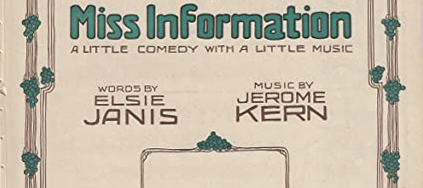
Musical
Musique: Musique additionelle: Cole Porter • Herman Finck • Jerome Kern • Paroles: Livret: Charles W. Goddard • Paul Dickey • Production originale: 1 version mentionnée
Dispo: Résumé Génèse Liste chansons
Il s'agit plus d'une pièce de théâtre avec des chansons qu'un réel musical. Mais il y contient une chanson de Jerome Kern et une chanson de Cole Porter.
Genèse: Les critiques ont adoré Elsie Janis, mais pour autant, Miss Information n’a tenu l’affiche que 6 semaines et 47 représentations.
La production a été présentée comme «A Little Comedy with a Little Music», et elle a peut-être donné l’impression d’être ni l’un ni l’autre avec ses sketches drôles et ses chansons occasionnelles. Le premier des trois actes était complètement dépourvu de musique, et l’un des neuf interludes musicaux (Pianologue) était un divertissement pour piano de Melville Ellis (qui était également le costumier du spectacle), un autre était une pièce instrumentale (The Mix-Up Rag, que Charles Darnton a décrit dans le Daily Arkansas Gazette comme «un mélange de ragtime et de vengeance»), et un troisième était soutenait un numéro de danse pour Janis (Dance Eccentrique). Les six autres chansons ont été composées par neuf paroliers et compositeurs !!! Difficile d’obtenir un spectacle cohérent…
Résumé: L’histoire tournait autour de la famille Cadwalder, une famille de nouveaux riches en pleine ascension sociale. Mme Cadwalder et sa fille Joan espèrent profiter de la publicité des journaux en affirmant que le collier de perles de 60.000 $ de Mme Cadwalder a été volé à sa résidence de Riverside Drive. Son fils Jack coopère quand il cache le collier, informe la police de sa disparition, et offre une récompense de 10.000 $ pour son retour.
Dot (Elsie Janis) est téléphoniste au quartier général de la police, et quand elle entend parler du vol, elle décide de jouer au détective, de récupérer le collier, et de réclamer la récompense. Nous la voyons bientôt à la maison Cadwalder quand elle prend l’apparence d’un messager de Western Union, et plus tard prétendant être une amie de la famille. Quand les Cadwalder partent pour l’Europe, Dot se déguise en diseuse de bonne aventure française, en servante allemande, en dandy anglais et en danseuse parisienne (permettant à Elsie Janis deux numéros de danse, Dance Eccentrique et Drigo Serenade, que le New York Times a décrits comme «captivants»).
Dot finit par tomber amoureuse de Jack, et pendant ce temps les perles sont vraiment volées (par une bande de voleurs de bijoux). Mais tout va bien car Dot capture à la fois les perles et le cœur de Jack.
Principales versions:
1. George M. Cohan's Theatre (Broadway-Etats-Unis)
05/10/1915 13/11/1915
47 représ.
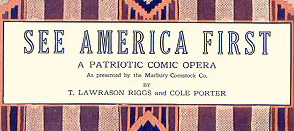
Musical
Musique: Cole Porter • Paroles: Cole Porter • Livret: Thomas Lawrason Riggs • Production originale: 1 version mentionnée
Dispo: Résumé Génèse Liste chansons
See America First est le musical avec la plus courte série de la saison 1915-16 à Broadway, mais il fait partie de l’histoire du théâtre en tant que première partition intégrale à Broadway composée par Cole Porter (plus tôt dans la saison, il avait déjà composé une chanson pour Hands Up et une chanson pour Miss Information).
Genèse: En 1915, Elizabeth Marbury, une agent et productrice influente de la côte Est, engage Cole Porter pour composer un spectacle musical professionnel appelé See America First.
See America First a été écrite comme une parodie des musicals patriotiques de l'époque (nous sommes en pleine Première Guerre Mondiale en Europe) généralement associées à George M. Cohan. Cole Porter et T. Lawrason Riggs ont rajouté une couche en assaisonnant leur travail par une touche de satire du style Gilbert et SullivanSullivan.
Des try-out eurent lieu le 22 février 1916 au Van Curler Opera House de Schenectady, puis le 24 février au Harmanus Bleecker Hall d'Albany, le 28 février au Lyceum Theatre de Rochester. Après une pause, le 22 mars 1916, un nouveau try-out eut lieu au Shubert Theatre de New Haven. Ce fut un vrai désastre lorsqu’un âne utilisé dans le deuxième acte a refusé de se jouer devant le public. Il a complètement arrêté le spectacle avec ses pitreries, ruinant toute continuité dramatique entre les actes. Le lendeain, les choses se déroulèrent mieux au Grand Opera house de Providence.
La production de Broadway a enfin ouvert le 28 mars 1916 au Maxine Elliott Theatre. La veille au soir, Elisabeth Marbury - l'une des premières femmes productrices - avait organisé un gala pour ses amis de la société et ses associés d'affaires. Ils étaient tous enthousiasmés par le spectacle. Mais le lendemain, les critiques furent beaucoup moins enchantés et le spectacle s'est arrêté après seulement 15 représentations, le pire flop de la saison.
Nombreux ont imputé la responsabilité de l'échec à T. Lawrason Riggs et à son livret, tandis qu'il a à son tour insisté sur le fait que cela était dû en grande partie «au fait que le compositeur et moi avons consenti à une transformation complète de la pièce pour répondre aux capacités de ses interprètes et au goût supposé de le public.» Dans une lettre au magazine des anciens de Yale, Riggs, qui avait investi 35 000 $ dans la production du spectacle, a annoncé qu'il abandonnait le théâtre musical comme vocation. Il se convertit au catholicisme, devint prêtre et a finalement été affecté à l'université en tant qu'aumônier.
Résumé: Le riche sénateur Polly Huggins - xénophobe notire - de la côte Est envoie sa fille Polly dans l’Ouest pour une fin de scolarité articulée autour d’un «retour à la nature», espérant qu’elle y trouverait un «vrai homme» pour un mari.
Mais les espoirs de Polly sont tout autres. Elle a des vues sur un Duc avec qui elle a échangé des regards à l’opéra à Londres. Le duc apparaît (!?!) dans la campagne reculée de l’Ouest déguisé en cowboy (re-!?!), et après quelques numéros musicaux, lui et Polly décident de se marier.
Heureusement, le père de Polly ne va pas empêcher ce mariage car il renonce à ses doctrines rigides par intérêt personnel : il est lui-même tombé amoureux de Sarah, la chaperonne provinciale de l’école de Polly.
Principales versions:
1. Maxine Elliott's Theatre (Broadway-Etats-Unis)
28/03/1916 08/04/1916
15 représ.
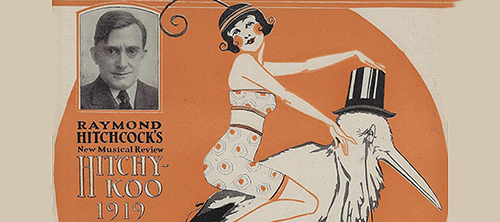
Revue
Musique: Cole Porter • Paroles: Cole Porter • Livret: George V. Hobart • Production originale: 1 version mentionnée
Dispo: Génèse Liste chansons
Retour de Cole Porter à Broadway après le terrible échec de See America First (1916).
Genèse: Après l’échec lamentable de la première production professionnelle de Cole Porter, il fait une courte pause et part en France pour étudier la musique et participer à l’effort de guerre dans le cadre de la Légion étrangère. Il a continué à composer des chansons et a gagné un public reconnaissant en France, où il est rapidement devenu la coqueluche de la société parisienne. C’est également à Paris qu’il a rencontré sa future épouse, la divorcée et mondaine américaine Linda Lee Thomas. Pendant le voyage de retour à la maison pour demander à son père une allocation de mariage, Porter a été engagé pour composer sa prochaine comédie musicale professionnelle.
Raymond Hitchcock, producteur de théâtre, a entendu Porter jouer certaines de ses chansons et lui a demandé d’écrire la musique du spectacle Hitchy-Koo de 1919. Après un try-out à Atlantic City et Boston, Hitchy-Koo est présenté pour la première fois à New York le 6 octobre 1919 au Liberty Theater. Le livret a été écrit par George Hobart et la série mettait en vedette Raymond Hitchcock. Le plus grand succès de la chanson du spectacle a été la sentimentale « An Old-Fashioned Garden », qui s’est vendue à deux millions d’exemplaires à un public fatigué de la guerre et assoiffé de nostalgie. Le spectacle a été accueilli avec enthousiasme et a duré 56 représentations.
Principales versions:
1. Liberty Theatre (Broadway-Etats-Unis)
06/10/1919 22/11/1919
56 représ.

Musical
Musique: Cole Porter • Willie Redstone • Paroles: Clifford Grey • Livret: George Grossmith • Production originale: 1 version mentionnée
Dispo: Résumé Commentaire Génèse Isnpiration Liste chansons
"A Night Out" est une comédie musicale adaptée de la comédie française , "L’Hôtel du libre échange" de Georges Feydeau et Maurice Desvallières (1894).
Genèse: Le musical a été présentée pour la première fois au Winter Garden Theatre de Londres le 18 septembre 1920 et a été jouée 309 fois, se terminant le 19 juin 1921. Une compagnie itinérante présenta la pièce dans les provinces britanniques en 1921, avec Norman Griffin dans le rôle principal de Pinglet. En 1925, la comédie musicale a été produite aux États-Unis mais n'a jamais atteint Broadway. Ce fut un "closed on the road".
Résumé: Acte I
Le sculpteur Joseph Pinglet est frappé par son épouse dominatrice et est prêt à se rebeller par une petite sortie non autorisée. Il a l'intention de dîner avec la jolie Marcelle Delavaux, la fiancée négligée de Maurice Paillard, dans une salle privée de l'hôtel Pimlico. Mais Madame Pinglet a été convoquée pour rendre visite à sa sœur malade, et elle enferme son mari dans son atelier avant de partir. Pinglet utilise le tire-cloche comme une corde et s'échappe par le balcon.
Acte II
Pinglet et Marcelle sont arrivés à l'hôtel. À leur insu, Monsieur Matthieu et ses quatre jeunes filles, ont eux reçu une chambre réputée hantée. Par un oubli, la même chambre a également été attribuée à Maurice Paillard, qui a l'intention de passer une soirée intime avec Victorine, la bonne des Pinglets. Pinglet et Marcelle sont dérangés par les coups frénétiques à leur porte et la voix de Paillard, qui a été terrifié de trouver dans sa chambre quatre personnages en blanc - les filles de Matthieu - qu'il suppose être des fantômes. La confusion est aggravée par une descente de police. La police prend les noms de toutes les personnes présentes. Victorine lui donne le nom de Madame Pinglet.
De retour à son atelier, Pinglet monte juste avant le retour de sa femme. Elle est très échevelée suite à un accident de la circulation. Les convocations arrivent de la police. Pinglet voit le nom de Mme Pinglet sur l'une d'elles et se retourne contre sa femme déconcertée et lui reproche son comportement licencieux. Les policiers arrivent avec les autres qui ont été à l'hôtel. Dans toutes les péripéties qui suivent la prétendue imposture de Victorine, le rôle de Pinglet et Marcelle dans les événements de la soirée restent sertets et ils échappent aux conséquences néfastes de leur soirée.
Principales versions:
1. Winter Garden Theatre (Londres-Angleterre)
19/09/1920 19/06/1921
309 représ.

Revue
Musique: Cole Porter • George Gershwin • Irving Berlin • Max Darewski • Paroles: Livret: John Hastings Turner • Production originale: Chales B. Cochran • 1 version mentionnée
Dispo: Génèse
Une revue produite et mise en scène par C.B. Cochran.
Genèse: Le spectacle comportait trois ballets: un spectacle inca autour du culte du soleil, raconté par Lady Tree avec Alice Delysia comme victime sacrificielle; un ballet florentin avec Nikitina; et un ballet sur l’escalier de Versailles. Les différentes scènes se déroulent à Cannes, Genève, en Chine, sur l’île de la mer du Sud, à Versailles, à Marseille et au Pérou. Il a été décrit comme «l’un des spectacles de scène les plus brillants et luxueux de la Londres actuelle. La réalisation suprême de Mr Cochran en tant que producteur d’imagination et de goût artistique exigeant» (The Stage). Ce fut la première apparition de Lady Tree dans une revue, même si elle apparaît simultanément dans la pièce en un acte de J.M. Barrie Shall We Join the Ladies pièce jouée en lever de rideau avant Loyalties au St Martin’s Theatre. Sa pièce a eu plus de succès, et a duré plus longtemps que la revue.
Le spectacle a reçu un accueil mitigé, et il a subi un coup fatal lorsque Delysia a perdu sa voix à cause d’une infection de la gorge et a dû se retirer de la distribution six semaines après le début de la représentation. Un spécialiste de la gorge lui a ordonné de reposer sa voix pendant trois mois. Sans sa star, le spectacle n’a pas réussi à attirer le public, et Cochran l’a fermé après moins de deux mois, subissant une perte de 20.000£.
Principales versions:
1. Oxford Music Hall (Londres-Angleterre)
09/03/1922 20/05/1922
77 représ.

Revue
Musique: Cole Porter • Paroles: Cole Porter • Livret: Harold R. Atteridge • Production originale: 1 version mentionnée
Dispo: Génèse
Genèse: Après que Porter ait composé la musique de l’édition de 1919 de la série de revues Hitchy-Koo de Ray Hitchcock, Jerome Kern a contribué à la majeure partie du matériel musical de la production de l’année suivante. Après une année sans nouvelle entrée (au cours de laquelle la star/producteur est apparue dans Ziegfeld’s Follies), Hitchcock a de nouveau employé les services de Porter pour son Hitchy-Koo de 1922, qui, contrairement aux quatre sorties précédentes, a été produit par les Shubert.
Le Hitchy-Koo de 1922 a commencé ses try-out le 10 octobre 1922 au Sam S. Shubert Theatre de Philadelphie, mais a duré moins de deux semaines. C’était le dernier de la série et le seul spectacle à ne pas être joué à Broadway, bien qu’il ait fait une tournée aux États-Unis.
Principales versions:
1. Shubert Theatre (Philadelphia-Etats-Unis)
10/10/1922 24/10/1922
15 représ.

Danse
Musique: Cole Porter • Paroles: Livret: Gerald Murphy • Production originale: 2 versions mentionnées
Dispo: Résumé Génèse Liste chansons
L’importance de Within the Quota réside dans le fait qu’il s’agit du premier ballet à thème américain mis en musique par un compositeur américain. Il a également été le véhicule d’un des plus improbables collaboration dans l’histoire musicale entre le jeune et riche Cole Porter, leader d’une jest-set série internationale, et le distingué, peu mondain, compositeur et théoricien français Charles Koechlin, qui a orchestré le ballet en 1923 à l’âge de cinquante-cinq ans.
Within the Quota était une satire de la vie américaine et de la mythologie du succès instantané. Cole Porter a écrit la musique; son ami de Yale et expatrié Gerald Murphy a conçu les décors.
Genèse: Au début des années 20, les Ballets Suedois étaient un jeune groupe de danseurs suédois dont les œuvres se caractérisaient par la fusion complète des arts visuels et musicaux. La création du monde, écrite par Darius Milhaud pour le Suédois, a été complétée par les décors des plasticiens Ferdinand Léger et Blaise Cendrars.
Lorsque Gerald Murphy a été engagé pour créer une séquence d’ouverture pour la troupe, qui serait jouée en première partie de La création du monde, il espérait que Cole Porter pourrait composer la musique. À ce stade de sa carrière, Porter ne s’était figé dans aucun domaine musical et sa femme Linda espérait qu’il deviendrait un compositeur sérieux. Ils fréquentaient déjà des sommités telles que Stravinsky, Fauré et Satie.
C’est Milhaud qui a demandé à Porter de composer le ballet. Ballet pantomime, il dépeint un Suédois frustré qui, ayant immigré aux États-Unis, découvre que tout ce qu’il désire en termes de boisson, de danse et d’amour est interdit ici. La toile de fond scénique de la pantomime était une énorme page du journal de Randolph Hurst, avec des titres fantastiques satirisant les mœurs américaines modernes. Within the Quota est devenu connu comme le premier ballet de jazz de son époque. La partition descriptive et dissonante utilise les sons de la ville, alors que Porter donne vie à New York dans l’orchestre avec les sons de la circulation, de la foule et des sifflets et des klaxons des bateaux dans le port.
La première a eu lieu au Théâtre des Champs-Élysées à Paris le 25 octobre 1923. Il a été accueilli encore plus favorablement que La création du monde, avec lequel il était programmé, mais la partition a été perdue. La musique a finalement été récupérée et enregistrée en 1989 par le London Sinfonietta.
Résumé: Un immigrant débarque en Amérique et rencontre successivement une variété de types d’Américains – mi-réels, mi-mythiques – qu’il connaît déjà grâce à ses visites au cinéma. Son plaisir en compagnie d’une héritière, d’un actuer de Vaudeville qui se pavane, d’un enfant du jazz et d’un cow-boy est interrompu par des apparitions répétées du puritain américain, qui est dépeint tour à tour comme un réformateur social, un agent du fisc, un élévateur et un shérif. Enfin, il rencontre l'amour, un personnage de Mary Pickford qui l’embrasse et, accompagné par des caméras cliquetantes, supervise sa métamorphose d’immigrant brut en star de cinéma.
Principales versions:
1. Théâtre des Champs-Elysées (Paris-France)
25/10/1923 //
représ.
2. Century Theatre (Broadway-Etats-Unis)
28/11/1923 //
représ.
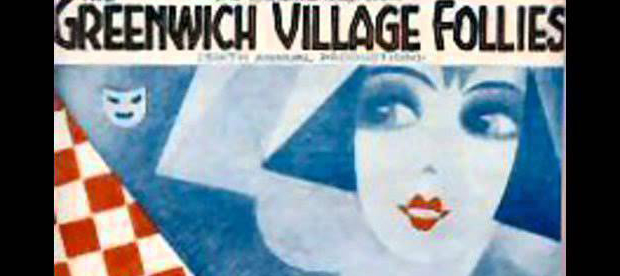
Revue
Musique: Cole Porter • Paroles: Cole Porter • Livret: Irvin Caesar • Lew M. Fields • William K. Wells • Production originale: 1 version mentionnée
Dispo: Génèse Liste chansons
The Greenwich Village Follies est une revue produite par John Murray Anderson, qui a engagé Cole Porter pour composer la musique. Bien qu’il vive toujours à Venise et qu’il voyage à travers l’Europe, Porter accepte de s’engager professionnellement, bien que nonchalamment.
Genèse: La partition de Porter comprend le succès bien connu « I’m in Love Again », inspiré en partie par l’engouement romantique de Porter pour Boris Kochno des Ballets russes. Le numéro « Two Little Babes in the Wood » a également été écrit pour cette production.
Le spectacle a été présenté pour la première fois le 16 septembre 1924 au Sam S. Shubert Theatre de New York et n’a duré que 127 représentations avant d’être envoyé sur la route.
Pendant ce temps, Porter a continué à se considérer comme un playboy voyageant dans le monde entier plutôt que comme un auteur-compositeur professionnel.
Principales versions:
1. Shubert Theatre (Broadway-Etats-Unis)
16/09/1924 03/01/1925
127 représ.

Revue
Musique: Cole Porter • Paroles: Cole Porter • Livret: Production originale: 1 version mentionnée
Dispo: Génèse
La Revue Des Ambassadeurs ouvre ses portes à Paris au Café des Ambassadeurs le 10 mai 1928.
Genèse: La riche partition est remplie des paroles les plus spirituelles de Porter, tandis que la production mettait en vedette le chant de Francis Gershwin, sœur de George et Ira, dans un medley de chansons de son frère. Soutenue par Fred Waring et ses Pennsylvaniens, elle a contribué à faire de la série un grand succès. Plusieurs des chansons de Porter pour le spectacle sont d’actualité satirique, comme l’osée « Pilot Me », dont les paroles combinent les événements en tête d’affiche du vol transatlantique de Charles Lindbergh avec une série de doubles sens sexuels. D’autres, comme « Looking at You », ont été de tels succès qu’ils ont été réutilisés dans des spectacles ultérieurs. La Revue a été bien accueillie et a rapidement conduit à un engagement professionnel à New York. La carrière de Porter a finalement été officiellement lancée.
Principales versions:
1. Café des Ambassadeurs (Paris-France)
10/05/1928 //
représ.

Musical
Musique: Cole Porter • Louis Alter • Walter Kollo • Paroles: Cole Porter • E. Ray Goetz • Roy Turk • Livret: Martin Brown • Production originale: 2 versions mentionnées
Dispo: Résumé Commentaire Génèse Liste chansons
Le musical, créée à Broadway en 1928, est le premier succès de Porter à Broadway. Le spectacle présente la chanson de Let’s Do It, Let’s Fall in Love chantée par la star du spectacle, Irene Bordoni. L’histoire concerne un jeune homme d’une très bonne famille à Newton, Massachusetts, dont la mère est horrifiée par son intention d’épouser une actrice française.
Genèse: Paris a commencé ses Try-Out au Nixon’s Apollo Theatre (Atlantic City) le 6 février 1928. Ce n’était qu’un début… Un nouveau Try-Out a ouvert la semiane suivante à l’Adelphi Theatre (Philadelphie), le 13 février 1928. Ce fut ensuite le Wilbur Theatre (Boston) le 7 mai 1928 et enfin le Poli Theatre (Washington DC) le 30 septembre 1928.
La première à Broadway a eu lieu au Music Box Theatre le 8 octobre 1928 et le spectacle a fermé le 23 mars 1929, après 195 représentations. Le musical était mis en scène par William H. Gilmore avec des chorégraphies de "Red" Stanley . La distribution mettait en vedette l’épouse de Goetz, Irene Bordoni (Vivienne Rolland), Arthur Margetson (Guy Pennel), Louise Closser Hale (Cora Sabot), Eric Kalkhurst (Andrew Sabot) et Elizabeth Chester (Brenda Kaley).
En 1929, Warner Brothers adapta le musical au cinéma avec toujourts Bordoni en tête d’affiche, cette fois accompagnée de Jack Buchanan , Jason Robards Sr. et ZaSu Pitts .
Résumé: Mme Cora Sabot est une matriarche autoritaire, puritaine et hautaine qui vit dans le Massachusetts. Son fils Andrew compte épouser la célèbre actrice de scène française Vivienne Rolland. Mme. Sabot se rend à Paris et décide que l’actrice n’est pas du calibre qu’elle souhaite pour son fils, et décide de compromettre ce mariage.
Elle a un plan audacieux: durant une soirée, elle boit et feint l’ivresse. Sous l’influence prétendue de l’alcool, elle semble tomber amoureuse de Guy Pennel, le partenaire à la scène de Vivienne. Cependant, elle s’enivre et se transforme en femme passionnée. Le plan de Mme Sabot fonctionne, et Vivienne se rend compte qu’elle et Guy sont faits pour être en couple dans la vie comme à ;la scène. Andrew doit se résigner mais comprend vite que Brenda Kaley, aussi lente et obtuse qu’elle soit, fera la parfaite épouse.
Principales versions:
1. Music Box Theatre (Broadway-Etats-Unis)
08/10/1928 23/03/1929
195 représ.
2. *** Film (***-***)
07/11/1929 //
représ.
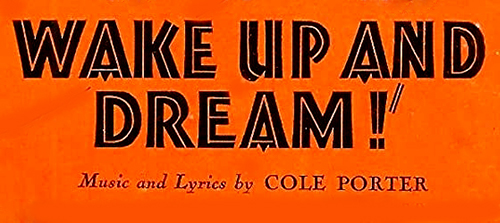
Revue
Musique: Cole Porter • Paroles: Cole Porter • Livret: *** Revue • John Hastings Turner • Production originale: 2 versions mentionnées
Dispo: Résumé Commentaire Génèse Liste chansons
Wake Up and Dream est une revue musicale avec un livret de John Hastings Turner et des musiques et paroles de Cole Porter et d’autres. La chanson la plus célèbre de la revue est le standard de Porter What Is This Thing Called Love?.
La revue a ouvert à Londres alors que l Paris)> de Porter était encore en cours sur Broadway. Le producteur Charles B. Cochran a demandé à Porter d’écrire la partition, même si dans leurs relations précédentes Porter l’avait traité avec un certain manque de courtoisie. Après Londres un vrai succès à Londres au London Pavilion, la revue a ouvert à Broadway le 30 décembre 1929, étant la dernière à avoir été créée à Broadway dans les années '20.
Genèse: La spectacle s’appelait à l’origine Charles B. Cochran's 1929 Revue. . Les try-out ont commencé le 5 mars 1929 au Palace Theatre de Manchester, en Angleterre. Il est ensuite créé le 27 mars 1929 au Pavillon de Londres et a été interprété 263 fois. La production a été dirigée par Frank Collins avec une chorégraphie de Jack Buchanan, Tilly Losch et Max Rivers, avec un casting qui comprenait Jessie Matthews, Sonnie Hale, Tillie Losch, Douglas Byng et Elsie Carlisle.
Après la fermeture de la production londonienne, une version est présentée à Broadway au Selwyn Theatre le 30 décembre 1929. Elle a fermé le 26 avril 1930 après 136 représentations. Produit par Arch Selwyn en association avec Cochran, le metteur en scène et chorégraphe londonien reprenait leur travail, et le casting comprenait Buchanan (qui remplace Hale), Matthews et Losch.
Résumé: Le spectacle était une revue avec 24 ensembles, 500 costumes, un grand casting international et "livret aussi épais qu'un cheveu". La chanson Let’s Do It, Let’s Fall in Love (interprétée à Londres) avait une chorégraphie sensuelle et était placée devant un grand idole africain, avec un rythme de tam-tam beat avec Tilly Losch dansant et Elsie Carlisle chantant dans cette chanson mélodramatique. Le ballet élaboré de la chanson Wake Up and Dream fait appel au folklore et à l’histoire. Coppélia est dansée comme si on la voyait depuis les coulisses. Selon le critique Brooks Atkinson du New York Times, « un numéro 'gothique', sur une musique de Bach, apporte la révérence de la cathédrale dans le théâtre.
Principales versions:
1. London Pavilion (Londres-Angleterre)
27/03/1929 09/11/1929
262 représ.
2. American Airlines Theatre (Broadway-Etats-Unis)
30/12/1929 26/04/1930
136 représ.
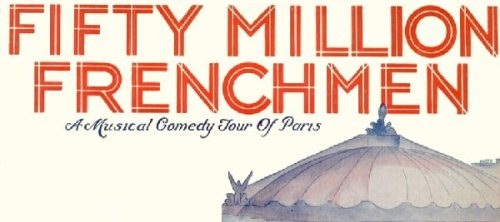
Musical
Musique: Cole Porter • Paroles: Cole Porter • Livret: Herbert Fields • Production originale: 2 versions mentionnées
Dispo: Résumé Synopsis Commentaire Génèse Liste chansons
Fifty Million Frenchmen est un musical avec un livret d'Herbert Fields et une musique et des paroles de Cole Porter. Il a ouvert ses portes à Broadway en 1929 et a été un grand succès. Il a été adapté pour un film deux ans plus tard.
Le titre fait référence à la chanson à succès de 1927 Fifty Million Frenchmen Can't Be Wrong de Willie Raskin, Billy Rose et Fred Fisher, qui comparait les attitudes libres dans le Paris des années ‘20 à la censure et à la prohibition régnant aux États- Unis .. L'intrigue de la comédie musicale est cohérente avec les intrigues standard garçon-rencontre-fille des musicals de la première moitié du XXe siècle.
Genèse: Fifty Million Frenchmen de Cole Porter a été qualifiée de «Musical Comedy Tour of Paris», et le tract pour le Try-Out de Washington tentait de séduire le public avec la promesse d’un «tour de luxe». Oui, pour le prix d’un «siège réservé», un spectateur pourrait «se promener dans les bois dans une barouche ouverte (calèche), visiter des champs de bataille, boire des cocktails au champagne au bar du célèbre Ritz, manger de la pâtisserie française chez Rumpelmeyer ou faire des galipettes au Moulin Rouge». Cet itinéraire imaginatif et provocateur comprenait également «La Tombe de Napoléon, la Madeleine, les cartes postales osées du Café de la Paix, les douairiers dansant avec les gigolos, les Citroën de Montmartre, les cocottes françaises, le Harry’s American Bar, la Place Vendôme, le Château Madrid et enfin le cher American Express». Ainsi, pour le prix d’un billet de théâtre (la place la plus chère pour la production de Broadway vendue pour 5,50$), le spectateur pouvait faire tout ce voyage accompagné par la musique de Cole Porter qui contenait de sublimes sérénades ( You Do Something to Me ) ou des demandes impertinentes ( Where Would You Get Your Coat?). Cole Porter avait été un peu joué à Broadway, mais c’est le spectacle qui l’a mis en pleine lumière. Il s’est joué pour 254 performances, a offert un trésor de chansons mémorables, et a finalement été filmé deux fois.
Fifty Million Frenchmen a été créé à Broadway au Lyric Theatre le 27 novembre 1929 et a fermé le 5 juillet 1930 après 254 représentations. L’ouverture a eu lieu un mois après le krach boursier de 1929. Mis en scène par Monty Woolley avec des chorégraphies de Larry Ceballos , une scénographie de Norman Bel Geddes , la distribution met en vedette William Gaxton dans le rôle de Peter Forbes, Geneviève Tobin dans le rôle de Loolooloo Carroll, Betty Compton dans celui de Joyce Wheeler et Lester Crawford dans celui de Billy Baxter.
Résumé: Peter Forbes, un jeune millionnaire américain à Paris, parie avec son ami Billy Baxter qu’il peut survivre un mois sans sa ligne de crédit tout en tentant de gagner la main de Looloo Carroll, une jeune fille qu’il aime. Il devient guide touristique, gigolo et magicien — endurant d’innombrables humiliations — avant de gagner le pari et les faveurs de la jeune fille.
Les autres personnages incluent l’ami de Peter, Michael, et l’amie de Looloo, Joyce, qui font équipe pour quelques numéros. Une grande partie de la comédie est fournie par Violet Hildegarde, une touriste de New York qui cherche à être choquée, et May DeVere, une artiste de cabaret à la recherche d’un homme assez primitif pour satisfaire ses besoins.
Principales versions:
1. Lyric Theatre (Broadway-Etats-Unis)
// 05/07/1930
254 représ.
2. *** Film (***-***)
14/02/1931 //
représ.

Film
Musique: Cole Porter • Jay Gorney • Paroles: Cole Porter • Livret: Gene Markey • Production originale: 1 version mentionnée
Dispo: Résumé
Un film fort peu connu, qui fut un flop, avec la première musique au cinéma de Cole Porter.
Résumé: Georgie, chanteuse et vendeuse de musique dans les rues de Paris, fait équipe avec Zizi, un pickpocket, et dans la fuite suite à une descente de police, elle rencontre Tony, un jeune artiste américain. Elle lui rendit son portefeuille le lendemain. Georgie est persuadée de rester et de poser pour lui, et c’est ainsi qu’ils tombent amoureux. Lorsque la guerre est déclarée, Tony s’engage et Georgie garde son appartement pour lui. Alors qu’elle est infirmière dans un grand hôpital à Paris, Georgie se lie d’amitié avec trois « mousquetaires » de la pègre parisienne; lorsque Tony rentre en permission, elle le trouve dans les bras de Suzanne, une serveuse de café. Avec ses amis, elle monopolise leur attention grâce à son talent musical. Plus tard, Suzanne l’attire hors de l’appartement et la fait emprisonner. Tony se joint aux amis pour la retrouver. Et après une bataille avec les méchants, les amants sont réunis.
Principales versions:
1. *** Film (***-***)
// //
représ.

Revue
Musique: *** Divers • Cole Porter • Paroles: *** Divers • Cole Porter • Dorothy Fields • E.Y. Harburg • Livret: Production originale: 1 version mentionnée
Dispo:
The Vanderbilt Revue était une soirée intime qui a ouvert et fermé en deux semaines et qui n’a pas fait beaucoup d’impression. Le consensus était qu’il manquait un point de vue et incluait du matériel original qui ne convenait pas à une revue, et donc même la présence de Lulu McConnell et du nouveau venu généralement bien reçu Joe Penner (et sa routine Wanna Buy a Duck?) n’a pas pu surmonter l’approche totalement éparpillée de la soirée pour les sketches, les chansons et les danses, 29 numéros en tout, qui étaient de vingt auteurs, paroliers et compositeurs différents.
Principales versions:
1. Vanderbilt Theatre (Broadway-Etats-Unis)
05/11/1930 15/11/1930
13 représ.
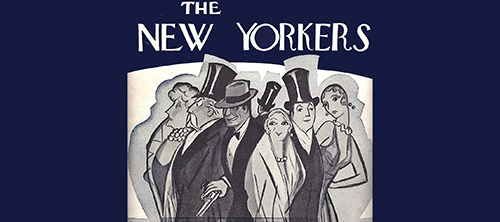
Musical
Musique: Cole Porter • Paroles: Cole Porter • Livret: Herbert Fields • Production originale: 2 versions mentionnées
Dispo: Résumé Commentaire Génèse Liste chansons
The New Yorkers est un musical écrit par Cole Porter (paroles et musique) et Herbert Fields (livret). La star Jimmy Durante a également écrit les paroles et la musique des chansons dans lesquelles son personnage était présent.
Le musical a été créé à Broadway en 1930. Il s'agit d'une satire des types new-yorkais, des matrones de la haute société aux escrocs, aux contrebandiers, voleurs et prostituées pendant la prohibition. Le musical comprend la célèbre chanson triste de Porter sur une prostituée, Love for Sale, qui a été interdite à la radio pour ses paroles franches. La production originale de Broadway a reçu des critiques positives et a été présentée pour 168 représentations.
Genèse: Le musical a été construit autour de l’humoriste vedette Jimmy Durante avec des morecaux créés précisément pour lui. En fait, Durante lui-même a écrit 5 des 17 chansons présentées dans le musical – les 5 seules chansons dans lesquelles il était l'interprète vedette.
The New Yorkers a commencé des try-out avant Broadway au Chestnut Street Opera House de Philadelphie, le 10 novembre 1930, siuvi de représentations au Shubert Theatre, à Newark, à partir du 24 novembre 1930.
Le musical a ouvert au Broadway Theatre le 8 décembre 1930 - première production de ce théâtre - et a fermé le 2 mai 1931 après 168 représentations. La mise en scène a été assurée par Monty Woolley, la chorégraphie par George Hale, les numéros spéciaux mis en scène et dirigés par Fred Waring, et la production supervisée par E. Ray Goetz. Les costumes ont été réalisés par Peter Arno et Charles Le Maire, et la scénographie a été réalisée par Dale Stetson, sur des croquis de Peter Arno. Le chef d’orchestre était Max Meth. Frances Williams dans le rôle de l’hôtesse Mona Low, Charles King dans celui d’Al Spanish, Hope Williams dans celui d’Alice Wentworth, Ann Pennington dans celui de Lola McGee, Marie Cahill dans celui de Gloria Wentworth, Fred Waring Orchestra, Lou Clayton dans celui de Cyril Gregory, Eddie Jackson dans celui de Ronald Monahan, Jimmy Durante dans le rôle de Jimmie Deegan, Kathryn Crawford dans celui de May (plus tard remplacée par Elisabeth Welch), et Oscar Ragland dans celui de Mildew.
Le musical a été présenté au Marriott Theatre dans le Lincolnshire en 1996. Musicals Tonight! a présenté le musical en concert à New York en avril 2003.
La série Lost Musicals a présenté The New Yorkers au Sadler’s Wells Theatre, à Londres, en mars et avril 2009, avec Anna Francolini dans le rôle d’Alice et Dawn Spence dans celui de Mona Low.
Le New York City Center l’a présenté en mars 2017 dans leur série de concerts Encores! avec Tam Mutu, Scarlett Strallen et Kevin Chamberlin, dans une mise en scène par John Rando.
Résumé: La riche mondaine new-yorkaise Alice Wentworth a une aventure romantique avec Al Spanish, propriétaire d’une boîte de nuit et contrebandier d’alcool. Pendant leur temps ensemble, ils échappent à la police et vivent de nombreuses aventures. Jimmy Deegan et ses copains Ronald et Oscar les aident dans leurs escapades, inventent une nouvelle boisson alcoolisée, assassinent Feet McGeehan et assistent au mariage d’Al et Alice au sein d’un gang, tout en rendant hommage à l’argent, au bois et à « The Hot Patata ». Des blagues et des chansons sur l’alcool et jusqu’où les gens sont prêts à aller pour l’obtenir, telles que « Drinking Song » et « Say It with Gin », reflètent l’origine de la comédie musicale à l’époque de la prohibition.
Principales versions:
1. Broadway Theatre (Broadway-Etats-Unis)
08/12/1930 02/05/1931
168 représ.
2. New York City Center (Broadway-Etats-Unis)
22/03/2017 23/03/2017
7 représ.

Musical
Musique: Cole Porter • Paroles: Cole Porter • Livret: Herbert Fields • Production originale: 0 version mentionnée
Dispo:
Après l’excitation de The New Yorkers (), l'équipe Porter (Paroles & musique), Herbert Fields (livret) et Ray Goetz (production) se lancent dans une nouvelle porduction intitulée Stardust. Le spectacle n’a jamais abouti sur scène, mais la musique contient certaines des meilleures chansons de Porter, dont The Physician et I Get a Kick Out of You, qui ont toutes deux été utilisées plus tard et sont devenues de grands succès. Parmi les autres chansons écrites pour ce spectacle, citons I Still Love the Red, White and Blue, Auf Wiedersehn et I’ve Got You on My Mind.
Principales versions:
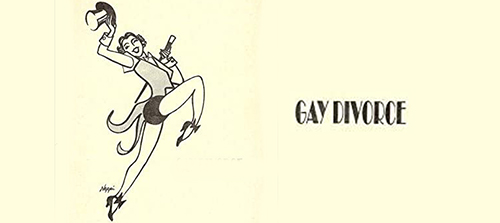
Musical
Musique: Cole Porter • Paroles: Cole Porter • Livret: Dwight Taylor • Production originale: 3 versions mentionnées
Dispo: Résumé Génèse Liste chansons
Gay Divorce est un musical avec des paroles et de la musique de Cole Porter et un livret de Dwight Taylor. Il s’agissait du dernier spectacle de Fred Astaire à Broadway et comprenait la chanson Night and Day dans laquelle Astaire dansait avec sa co-star Claire Luce.
Genèse: Gay Divorce a ouvert en try-out au Wilbur Theatre de Boston à partir du 7 novembre 1932, puis s’est déplacé au Shubert Theatre de New Haven à partir du 21 novembre 1932. Il a ouvert à Broadway au Ethel Barrymore Theatre le 29 novembre 1932 et a été transféré au Shubert Theatre le 16 janvier 1933 où il a fermé le 1er juillet 1933 après un total de 248 représentations. Mis en scène par Howard Lindsay avec des chorégraphies de Barbara Newberry et Carl Randall, une scénographie de Jo Mielziner.
Avec 248 représentations, le spectacle est devenu le deuxième musical de la saison, avant d’être adapté au cinéma en un film à succès qui a mis en vedette Fred Astaire et Ginger Rogers dans leur deuxième film, avec Eric Blore et Erik Rhodes re-créant les rôles qu’ils avaient joués à Broadway.
Vu le succès à Broadway qui s’est prolongé jusqu’au 1er juillet 1933, le spectacle a ouvert dans le West End londonien au Palace Theatre le 2 novembre 1933 et a été présenté pour 180 représentations. Il a été mis en scène par Felix Edwardes mais toujours avec Fred Astaire, Claire Luce, Erik Rhodes et Eric Blore reprenant leurs rôles. Ils ont été rejoints par Olive Blakeney (Gertrude Howard), Claud Allister (Teddy Egbert), Joan Gardner (Barbara Wray) et Fred Hearne (Octavius Mann).
Notons que, de façon assez compréhensible, What Will Become of Our Engalnd? (qui spéculait sur le Prince de Galles et sa vie amoureuse) a été retirée de la partition; et Porter a écrit trois nouvelles chansons pour la production, Never Say No, Waiters vs. Waitresses et I Love Only You.
En 1934, le musical a bénéficié d'une adaptation cinématographique. A l'affiche, on allait retrouver Fred Astaire (Guy Holden), Ginger Rogers (Mimi Glossop), Eric Blore (serveur) et Erik Rhodes (Rodolfo Tonetti). Mais aussi Alice Brady (Tante Hortense), Edward Everett Horton (Egbert 'Pinky' Fitzgerald) et Betty Grable (une cliente de l'hôtel).
Les règles de censure du cinéma de l’époque ne permettaient pas de traiter le sujet du divorce à la légère, ce qui a entraîné une légère modification du titre du film. La logique était qu’un divorce lui-même ne pouvait pas être «gai», mais qu’une personne divorçant pouvait l’être, et ainsi la «morale des cinéphiles du monde entier a pu être sauvée» lorsque le titre a été changé de Gay Divorce à The Gay Divorcee.
Résumé: Guy Holden (Fred Astaire), un écrivain américain en voyage en Angleterre, tombe follement amoureux d’une femme nommée Mimi (Claire Luce), qui disparaît après leur première rencontre. Pour lui permettre d’oublier cet amour manqué, son ami Teddy Egbert, un avocat britannique, l’emmène à Brighton, où il s’est arrangé pour aider une de ses clientes à obtenir le divorce de son ennuyeux et vieillissant mari, le géologue Robert. Comment? En faisant qu’il la surprenne avec un amant…
Egbert a donc payé un homme, Rudolfo Tonetti (Erik Rhodes), pour qu’il se fasse passer pour son amant. On va assister à un énorme quiproquo: le soir où tout doit se passer Mimi croit que Holden, qui accompagne son avocat Egbert, est la personne qui doit jouer le rôle de son amant. Holden n’ose la démentir car il a honte de sa propre activité, auteur de romans d’amour à bas prix… Lorsque le mari apparaît, il n’est pas convaincu par ce faux adultère mais le serveur (Eric Blore), involontairement, révèle que le mari n’est pas fidèle à sa femme, un vrai adultère cette fois...
Mimi peut donc épouser Guy Holden!
Principales versions:
1. Ethel Barrymore Theatre (Broadway-Etats-Unis)
29/11/1932 01/07/1933
248 représ.
2. Palace Theatre (Londres-Angleterre)
02/11/1933 07/04/1934
180 représ.
3. *** Film (***-***)
12/10/1934 //
représ.

Musical
Musique: Cole Porter • Paroles: Cole Porter • Livret: Guy Bolton • Production originale: 0 version mentionnée
Dispo: Génèse
Cole Porter a composé la musique de Once Upon a Time, également connu sous le nom de « Ever Yours », dans les années 1933-1934. Le livret de cette comédie musicale était basé sur une histoire de Lily Hatvany et Guy Bolton a collaboré avec Cole Porter à la réalisation de l’histoire. Le spectacle n’a jamais été produit, mais contient néanmoins de la bonne musique.
Genèse: L’une des chansons, « Miss Otis Regrets », est devenue un standard de jazz et une ballade bien connue. Les paroles racontent l’histoire d’une certaine Miss Otis, une dame de la haute société qui a été poussée à commettre un crime passionnel. Après avoir assassiné son amant, elle envoie un message à une connaissance alors qu’elle est traînée pour être pendue, qu’elle est incapable de respecter ses rendez-vous sociaux pour la journée. La mélodie mélancolique, presque chantante, contraste fortement avec la douce ironie des paroles, alors que Miss Otis est exécutée par une foule en colère.
Principales versions:
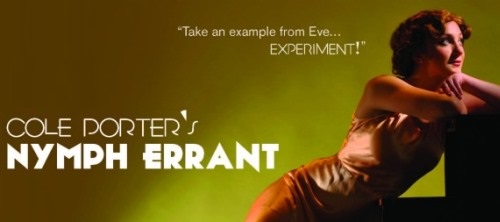
Musical
Musique: Cole Porter • Paroles: Cole Porter • Livret: Romney Brent • Production originale: 6 versions mentionnées
Dispo: Résumé Synopsis Commentaire Génèse Liste chansons
Les biographes de Cole Porter listent invariablement Kiss Me Kate, Anything Goes et Out of This World comme ses meilleurs partitions, mais Porter lui-même avait un spectacle qu'il citait toujours comme son préféré: Nymph Errant. Le choix de Porter est aujourd’hui à peine connu, mais en 1933 il représentait le top du top du théâtre musical.
Genèse: Nymph Errant était à l’origine un roman de 1932, écrit par James Laver - critique d’art et conservateur de musée - et qui raconte les aventures d’une jeune Anglaise nommée Evangeline Edwards, qui fait un tour du monde assez excentrique. Le producteur anglais Charles Cochran cherchait un spectacle pour Gertrude Lawrence - flamboyante et scandaleuse mais surtout l’une des plus grandes stars de Broadway et de Londres à l'époque. Il pensait que Nymphe Errant serait un choix parfait.
Cochran a rapidement engagé Cole Porter, qui sortait d’une série de succès à Broadway - notamment avec Gay Divorce, The New Yorkers et Fifty Million Frenchmen. Porter a amené avec lui son ami, le conteur/acteur/réalisateur Romney Brent, pour écrire le livret et mettre en scène le spectacle. Le processus d’écriture s’est avéré particulièrement harmonieux, puisque le romancier James Laver et le librettiste Rommey Brent ont rejoint Porter dans sa maison à Paris pour des séances d’écriture marquées par un travail acharné, des rires et des pauses champagne.
Après une tournée à Manchester (où la chanson-titre a été ajoutée), Nymph Errant a fait ses débuts dans l’un des plus grands et des plus glamour soirées d’ouverture que Londres ait jamais vu. "Experiment", "How Could We Be Wrong" et "It’s Bad For Me" ont été salués comme les nouveaux tubes de Porter, mais les arrêts-spectacles de cette soirée étaient la liste éblouissante des parties du corps de Lawrence, "The Physician" et la livraison de Solomon d’Elisabeth Welch, qui a été abandonnée de façon exaltante."
Gertrude Lawrence a été choisie pour incarner l’héroïne ingénue et Agnes B. de Mille a chorégraphié les ballets sensuels. Nymph Errant a été sa première grande production et l’a initiée au monde vibrant du théâtre musical.
Tout le monde théâtral transatlantique a assisté au prestigieux try-out à l’Opéra de Manchester. C'est durant ce try-out à Manchester que la chanson-titre a été rajoutée. Un grand nombre des membres de la famille royale, les plus puissants du monde ont bénéficié d’une projection de pré-ouverture diffusée en Amérique et Nymph Errant a connu une ouverture splendide à l’Adelphi Theatre de Londres le 6 octobre 1933. Ce fut l’une des plus grandes et des plus glamour soirées d’ouverture que Londres ait jamais vu. "Experiment", "How Could We Be Wrong" et "It’s Bad For Me" ont été salués comme les nouveaux tubes de Porter, mais les show-stoppers de cette soirée furent tous dûs principalement à Gertrude Lawrence.
Des foules et des foules se sont déplacées pour voir le spectacle et des fêtes au champagne ont été organisées par la suite. Les critiques, en particulier sur les paroles et la musique de Porter, ont été extrêmement bonnes. Les plus grandes chansons étaient « The Physician », « Experiment » et « Si Vous Aimez les Poitrines », toutes des chansons pleines d’esprit sur la séduction et la passion frustrée. Une autre chanson, intitulée « Salomon », avait été inspirée par le chant mélismatique [le style mélismatique s'oppose au style syllabique, dans lequel chaque syllabe du texte est chantée par une seule note] d’un groupe d’épouses d’un sultan turc. Cette chanson et « The Physician » ont reçu tellement d’applaudissements et d’acclamations qu’ils ont complètement arrêté la production. L’esprit, l’ironie romantique et l’implication passionnée sont les caractéristiques de la partition et des paroles. Malheureusement, le livre de Brent était faible et très critiqué. Après quelques mois, les problèmes financiers et de santé de Lawrence (elle souffrait d’épuisement) ont conduit à une fermeture anticipée de Nymph Errant, après 154 représentations. Fox Films avait prévu, puis abandonné, une version cinématographique et un transfert à New York ne s’est jamais matérialisé.
Il faut dire que Porter a immédiatement enchaîné avec son plus grand succès à ce jour, Anything Goes.
On n’a plus entendu parler de Nymph Errant jusqu’à ce qu’une partie du spectacle soit jouée dans Star! Le film biographique de 1968 de Julie Andrews sur Gertrude Lawrence.
La première américaine de Nymph Errant fut une présentation d’atelier par le Equity Library Theatre de New York en 1982.
Londres a accueilli un grand concert en 1987 avec Lisa Kirk, Alexis Smith, Kaye Ballard, Andrea McArdle et, étonnamment, Elisabeth Welch, chantant la chanson qu’elle avait introduite 55 ans plus tôt, "Solomon."
Une nouvelle version réécrite de Nymph Errant a été jouée au Chichester Festival en Angleterre en 1999. Il est peu probable que le spectacle jouisse d’une production de Broadway dans un proche avenir, mais la version originale de 1933 existe toujours pour nous rappeler l’héroïne naïve et amatrice de Laver et son odyssée amoureuse, l’esprit rusé et, bien sûr, le génie de Porter dans l’écriture de chansons drôles, émotives et glorieusement mélodiques.
Résumé: Evangline Edwards has left her finishing school in Switzerland and, encouraged to “experiment” by the school’s chemistry mistress, Miss Pratt, decides to explore the exciting world of sex and lose her virginity before settling down in England. Her “experiments” all fail! Attempted romances include Folies Bergère producer André de Croissant who wants to make her a star; Alexei, a Russian violinist who shows her the soul of Russian music; Count Mantalini of the Holy Roman Empire; Greek businessmen Constantine; and an unfortunate incident where she gets sold into a harem, guarded by Ali. Throughout it all, she is still a virgin. In the harem she meets Haidee, a kidnapped American, and when Ben Winthrop breaks into the harem to rescue Haidee, Evangeline persuades him to rescue her instead, and they run away together to the desert. But he is more interested in plumbing than in love-making. Back in Paris, Evangeline decides to join the Folies after all - enticed by the ten handsome chorus boys in the show. But they are all gay! She gives up and ends up back in Oxford in the vicarage garden with Reverend Pither and friends. As the others go in for tea, Evangeline remain behind. Along comes the new young handsome gardener Joe. They chat awhile, get closer and closer, and finally Joe offers Evangeline an apple. As she takes a bite from the apple, the curtain falls.
Principales versions:
1. Opera House (Manchester-Angleterre)
11/09/1933 //
représ.
2. Adelphi Theatre (Londres-Angleterre)
06/10/1933 17/02/1934
154 représ.
3. Drury Lane Theatre (Londres-Angleterre)
21/05/1989 21/05/1989
1 représ.
4. Chichester Festival Theatre (Chichester-Angleterre)
05/08/1999 //
représ.
5. Eureka Theatre (San Francisco-Etats-Unis)
05/10/2011 23/10/2011
représ.
6. Harold Clurman Theatre (Broadway (Off)-Etats-Unis)
07/07/2012 29/07/2012
représ.
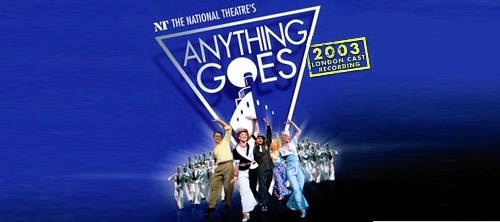
Musical
Musique: Cole Porter • Paroles: Cole Porter • Livret: Guy Bolton • P.G. Wodehouse • Production originale: 14 versions mentionnées
Dispo: Résumé Synopsis Commentaire Génèse
Genèse: Producer Vinton Freedley came up with the idea for the show as he was living on a boat at the time. He left the US to avoid his debts and used a boat as his residence. Freedley picked Guy Bolton and P. G. Wodehouse to write the book, and Ethel Merman to star in the production. The original plot was a comedy about a mad bomber running loose on an ocean liner. Freedley was not happy with the script and found it difficult to make changes when Bolton and Wodehouse sailed for Europe. In an odd turn of events, as rehearsals began, the passenger ship, the SS Morro Castle, sailing from Havana to New York on September 8, 1934, caught fire and burned. The disaster killed a total of 137 passengers and crew members before beaching herself near Asbury Park, New Jersey. This was the excuse that Freedley needed to completely revamp the show. He maintained that the tragedy made the plot of the show seem insensitve and that this would not work well with public opinion. As a result, the book was almost entirely recreated by the show's director, Howard Lindsay and press agent, Russell Crouse (who became lifelong writing partners as a result). They revised the script, finishing the last scene on the train to Boston, where the show was to open before hitting Broadway. The show opened on November 21, 1934, about two and a half months after the SS Morro Castle disaster.
There is a legend behind the name of the show and the title song. It is said that at a late night production meeting where the show was being reworked, one of the overly-tired production team members said in frustration "And just how in the hell are we going to end the first act?!" "At this point," responded one of the producers, "anything goes!!"
The show became a big hit and the confusion really begins. Two years later, the 1936 film version of Anything Goes hit the theatres and held little resemblance to the stage production. The book and score were dramaticaly changed with only two of the original songs included. Additional songs were included by Hoagy Carmichael and other composers.
18 years later in 1954, the television version changed the plot again and changed the songs again to include more of the original score than the movie version along with songs from other Cole Porter shows.
The second movie version was filmed in 1956 and the book was drastically changed once more with additional songs by Sammy Cahn and James Van Heusen. The second film named Anything Goes forced the first film version (1936) to be renamed Tops Is The Limit.
An Off-Broadway revival of Anything Goes opened on May 15, 1962 at the Orpheum Theatre. It starred Hal Linden as Billy Crocker and Eileen Rodgers as Reno Sweeney. The stage script was revised and incorporated several of the changes from the movie versions. The minor character named Erma was expanded and her name changed to Bonnie. This revival also added several songs from other Porter shows that came after the original production of Anything Goes. From the 1930 musical, The New Yorkers, came the song "Take Me Back to Manhattan," from the 1934 musical, Red Hot and Blue, came the song "It's De-Lovely," from the 1939 musical, DuBarry Was a Lady, came the song "Friendship," and from the 1929 musical, Paris, came the song "Let's Misbehave".
In October 19, 1987, a major revival of Anything Goes opened on Broadway at the Vivian Beaumont Theatre, with Patti Lupone in the role of Reno Sweeney and ran for 784 perfomances. The book was revised by Timothy Crouse and John Weidman. This production opened in London at The Prince Edward Theatre the following year.
Résumé: Billy Crocker est monté clandestinement à bord du navire de croisière « S.S. American » afin de tenter de reconquérir celle qu’il aime, Hope Harcourt, mais qui doit se marier avec un autre, le riche Lord Evelyn Oakleigh. Billy est soutenu par Reno Sweeney, une chanteuse qui tient toujours tendrement à lui, et par un autre passager clandestin, Moonface Martin, un gangster de second rang qui essaie d’échapper au FBI. Après des difficultés et des rebondissements, l’amour finira par triompher. La croisière s’achèvera par plusieurs mariages, dont certains inattendus.
Principales versions:
1. Neil Simon Theatre (Broadway-Etats-Unis)
05/11/1934 16/11/1935
420 représ.
2. Palace Theatre (Londres-Angleterre)
// //
261 représ.
3. *** Film (***-***)
24/01/1936 24/01/1936
représ.
4. *** TV (***-***)
02/10/1950 02/10/1950
représ.
5. *** TV (***-***)
28/02/1954 28/02/1954
représ.
6. *** Film (***-***)
// //
représ.
7. Orpheum theatre (Broadway (Off)-Etats-Unis)
// //
239 représ.
8. Saville Theatre (Londres-Angleterre)
18/11/1969 18/11/1969
15 représ.
9. Vivian Beaumont Theatre (New-York-Etats-Unis)
11/09/1987 03/09/1989
784 représ.
10. Prince Edward Theatre (Londres-Angleterre)
// 25/08/1990
représ.
11. Paper Mill Playhouse (Milburn-Etats-Unis)
06/09/2000 15/10/2000
représ.
12. National Theatre - Olivier Theatre (Londres-Angleterre)
11/12/2002 22/03/2003
80 représ.
13. Drury Lane Theatre (Londres-Angleterre)
24/09/2003 28/08/2004
387 représ.
14. Stephen Sondheim Theatre (Broadway-Etats-Unis)
10/03/2011 08/07/2012
500 représ.
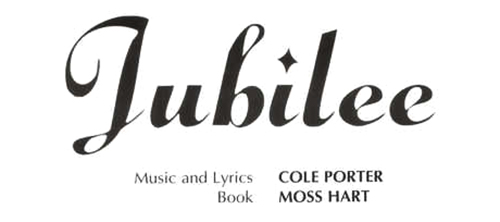
Musical
Musique: Cole Porter • Paroles: Cole Porter • Livret: Moss Hart • Production originale: 1 version mentionnée
Dispo: Résumé Génèse Liste chansons
Jubilee is a musical comedy with a book by Moss Hart and music and lyrics by Cole Porter. It premiered on Broadway in 1935 to rapturous reviews. Inspired by the recent silver jubilee of King George V of Great Britain, the story is of the royal family of a fictional European country. Several of its songs, especially "Begin the Beguine" and "Just One of Those Things", became independently popular and have become part of the American Songbook.
Genèse: The musical opened at the Shubert Theatre in Boston on September 21, 1935 for a three-week pre-Broadway tryout period. The Broadway premiere opened at the Imperial Theatre on October 12, 1935 and closed on May 7, 1936, after 169 performances. Changes in the lead lessened its appeal. Produced by Sam H. Harris and Max Gordon, the production was staged by Hassard Short, who also was the lighting designer, with dialog directed by Monty Woolley, choreographed by Albertina Rasch and Tony De Marco, and with set design by Jo Mielziner.
Later productions
Despite its popular success, the musical was not signed by a theatrical leasing company for stock or amateur performances after its initial run. Performances between 1936 and 1948 were negotiated by the producers Max Gordon and Sam Harris. In 1948, the St. Louis Municipal Opera used the original orchestrations, but they were lost in transit to the Music Box Theatre. Jubilee became a lost show. It was not produced for 40 years afterward.
In 1985, The New Amsterdam Theatre Company hired Larry Moore to reconstruct the show. It was performed in 1986 as part of their series of classic musicals presented in concert at The Town Hall in New York. Alyson Reed played Karen, Carole Shelley was Eva, Patrick Quinn was Eric, and Roderick Cook was the Prime Minister. Rebecca Luker was in the cast.
Indiana University Opera staged the musical in 1992.[8] 42nd Street Moon in San Francisco presented concert versions of Jubilee in 1993 and 1997 and a staged production in 2009.
In 1998, a concert version was staged at Carnegie Hall, New York City, for the benefit of the Gay Men's Health Crisis. Directed by Herbert Ross, with choreography by Danny Daniels, Lynne Taylor-Corbett and Pierre Dulaine, the cast included Bea Arthur as The Queen, Tyne Daly as Eva Standing, Sandy Duncan as Karen O'Kane, Michael Jeter as The King, Alice Ripley as The Princess, Stephen Spinella as Eric Dare, Bob Paris as Mowgli,[10] and Philip Bosco as Prime Minister. New York's "Musicals Tonight!" theatre troupe presented a staged concert in October 2004.
The show has been produced twice by Ian Marshall Fisher's "Lost Musicals In Concert" series in London. The second production, using the BBC Concert Orchestra, was performed in 1999 at Her Majesty's Theatre and broadcast by the BBC.
The musical played for five weeks in 2012 at the Tabard Theatre in Chiswick, London.
Résumé: The Royal Family of a fictional European country use the threat posed by an impending revolution as an excuse to abandon the throne and pursue their private dreams. The King meets up with party-giver extraordinaire Eva Standing; the Queen chases after swimmer-turned-actor Charles Rausmiller (a.k.a. Mowgli); the Prince woos songstress Karen O'Kane; and the Princess wins the admiration and attention of playwright/composer/actor Eric Dare. When the revolutionary threat is revealed to be a hoax, the family members are forced to return to power, but they manage to incorporate their newfound friends into their royal lives.
Principales versions:
1. Imperial Theatre (Broadway-Etats-Unis)
12/10/1935 07/03/1936
169 représ.
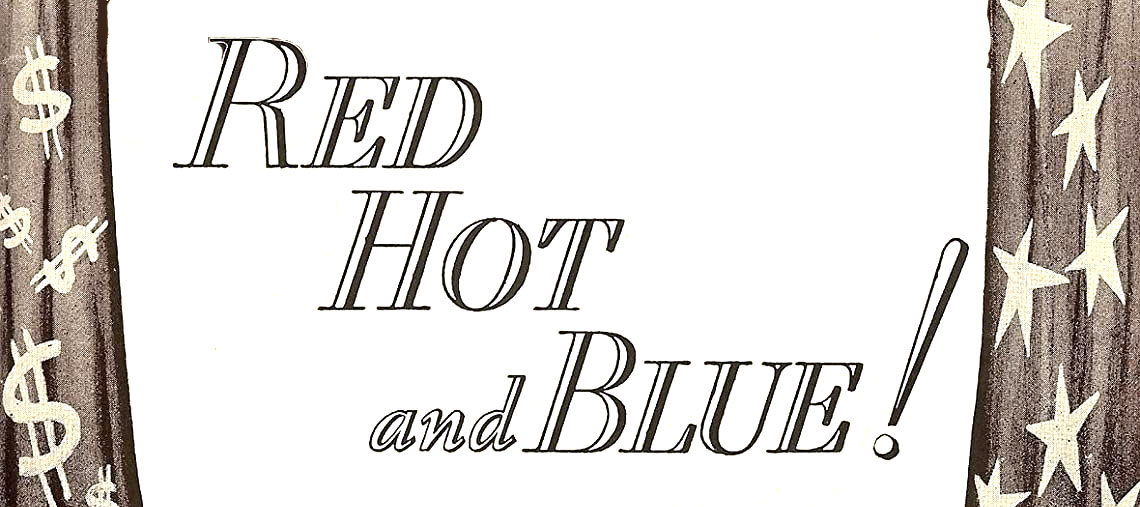
Musical
Musique: Cole Porter • Paroles: Cole Porter • Livret: Howard Lindsay • Russel Crouse • Production originale: 1 version mentionnée
Dispo: Résumé Commentaire Génèse Liste chansons
Red, Hot and Blue is a stage musical with music and lyrics by Cole Porter and a book by Howard Lindsay and Russel Crouse. It premiered on Broadway in 1936 and introduced the popular song "It's De-Lovely," sung by Ethel Merman and Bob Hope.
Genèse: History
During the out-of-town tryouts, according to Cole Porter's biography, Cole Porter: A Biography by Charles Schwartz, the book was too long and did not blend with the music. Further the producer Vinton Freedley made "numerous suggestions for overhauling the show", which were accepted by all except Porter. Porter initially told Freedley to communicate through his agent, but finally relented. Additional conflict had arisen before the show's tryouts, when Freedley had assembled the cast and creative team behind the musical Anything Goes, hoping to repeat that show's success. William Gaxton was part of that cast, but withdrew because Ethel Merman's part was so large and Bob Hope was cast. The next conflict came over billing for Jimmy Durante and Merman, which was resolved by having their names crisscrossed above the title.
The musical was first titled But Millions! and then Wait for Baby!.
Porter had written the song "It's De-Lovely" for the film Born to Dance but it was not used. He turned it into a romantic duet for Merman and Bob Hope, in which they trace their romance from first kiss to marriage to a baby.
Productions
Red, Hot and Blue had its pre-Broadway tryout in Boston at the Colonial Theatre, starting on October 7, 1936, and the Shubert Theatre in New Haven starting on October 19, 1936.
The musical premiered on Broadway on October 29, 1936 at the Alvin Theatre (now the Neil Simon Theatre) and closed on April 10, 1937 after 183 performances. Directed by Howard Lindsay with choreography by George Hale, it starred Ethel Merman as Nails O'Reilly Duquesne, Jimmy Durante as Policy Pinkle, and Bob Hope as Bob Hale.
The Equity Library Theater (New York City) production ran in January 1984.
The "Discovering Lost Musicals Charitable Trust" series staged the show at Barbican Centre Cinema 1 in 1994, with a cast that included Louise Gold and Don Fellows.
Goodspeed Opera House in East Haddam, Connecticut mounted a revival in the fall of 2000 featuring a revised book by director Michael Leeds. The production starred Debbie Gravitte (Tony Award winner for "Jerome Robbins' Broadway") as Nails Duquesne, Peter Reardon as Bob Hale, and Ben Lipitz as Policy Pinkle. Previews began October 13 with the official opening on November 3. The production ran through December 31. Along with Leeds, the creative team included Andy Blankenbuehler (choreographer), Michael O'Flaherty (musical director), Ken Foy (sets), Ann Hould-Ward (costumes), and Ken Billington (lighting). The rest of the cast included Brian Barry (Rats), Robin Baxter (Peaches), Lesley Blumenthal, Randy Bobish (Bugs), Dianna Bush (Olive), Paul Carlin, Kevin Covert (Leonard), Beth Glover, Billy Hartung (Fingers), Jessica Kostival (Grace), Stephanie Kurtzuba (Jane), Kristin Maloney (Helen), Steve Luker (Eagle Eye), Jody Madaras, Trish Reidy (Vivian), Vince Trani, Matt Williams (Coyote), and Darlene Wilson (Barbara).
A production in 2009 by George Productions had Richard Steven Horvitz as Policy Pinkle, Allyson Turner as Nails and Kyle Nudo as Bob Hale.
Résumé: Nails O'Reilly Duquesne is a newly wealthy young widow. Loud and brassy, Nails is a former manicurist. She organizes a benefit for her favorite cause, the rehabilitation of ex-convicts. Together with her sidekick (an "ex-con" himself), Policy Pinkle, and her "square" boyfriend, lawyer Bob Hale, she embarks on a nationwide search for Bob's old girlfriend, which is really the reason for the enterprise. The girlfriend, 18 years earlier, had sat upon a hot waffle iron and so had a unique "imprint". However, the national lottery that Nails starts gets the attention of the Finance Committee, and they wind up in Washington DC in an even more complicated situation. The Supreme Court declares the lottery unconstitutional, because it would benefit the people.
Principales versions:
1. Neil Simon Theatre (Broadway-Etats-Unis)
29/10/1936 10/04/1937
183 représ.
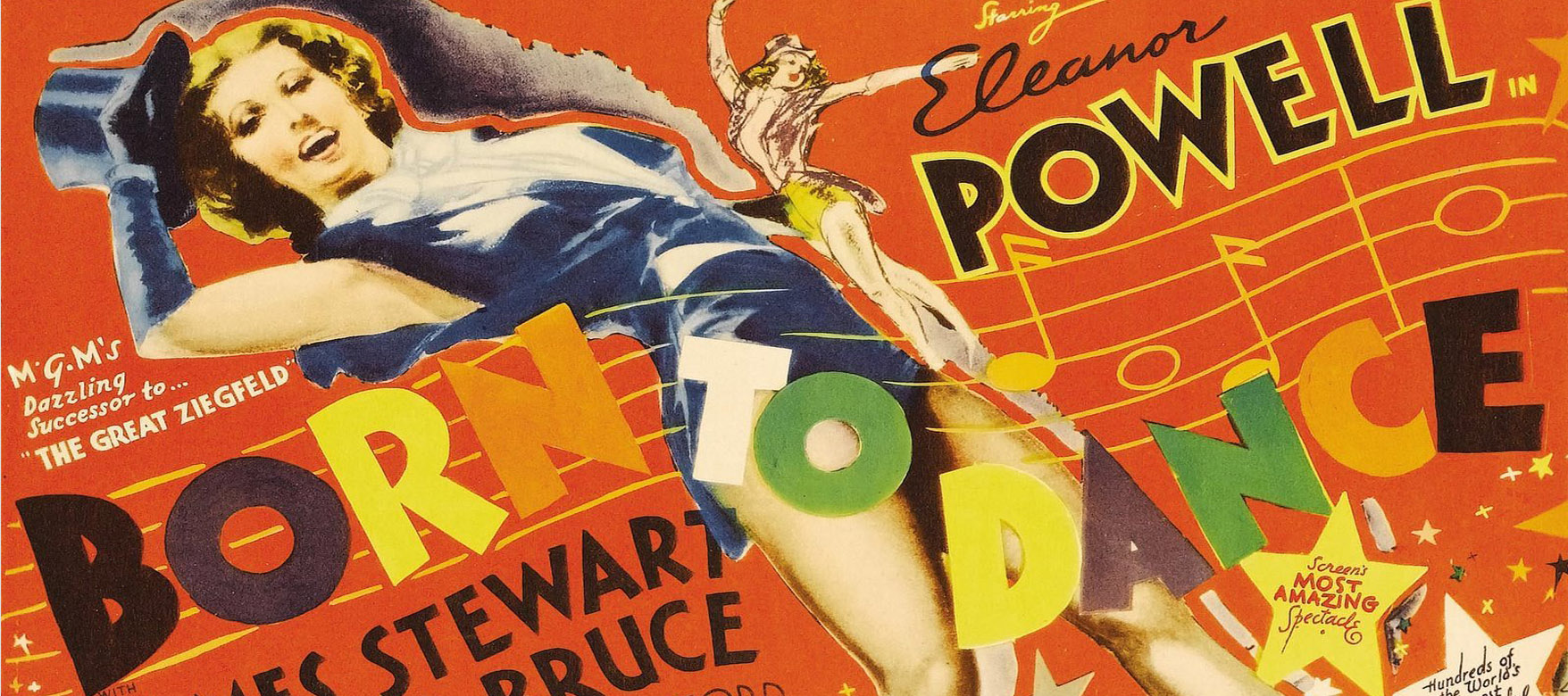
Film
Musique: Cole Porter • Paroles: Cole Porter • Livret: B.G. DeSylva • John McGowan • Sid Silvers • Production originale: 1 version mentionnée
Dispo: Résumé Liste chansons
Le premier vrai film de Cole Porter.
Résumé: Le film met en scène trois matelots de sous-marins, Ted Barker (James Stewart), Gunny Saks (Sid Silvers) et Mush Tracy (Buddy Ebsen), qui arrivent à New York après quatre ans de mer. Le film commence lorsque leur sous-marin atteint le port de New York, les marins chantant "Rolling Home". Alors que de nombreux marins sont en permission, Gunny et Mush ne peuvent débarquer avant que leur capitaine les envoie livrer une lettre au contre-amiral Stubbins. Nora Paige (Eleanor Powell), une chanteuse et danseuse qui vient d'être dégagée d'un spectacle de Broadway, entre au Lonely Hearts Club, valise à la main. La réceptionniste du club, Jenny (Una Merkel), lui propose de partager son appartement avec elle. Quand elle présente Nora aux autres personnes du club, Nora démontre ses talents en chantant et en dansant "Rap Tap on Wood" (les voix de Miss Powell sont doublées par Marjorie Lane).
Jenny se confie à Nora quant à son mariage avec un marin: ce dernier avait été son partenaire dans un marathon de danse de vingt-huit jours - très courants durant la crise de '29. Après le marathon, dans les deux jours qu’ils ont passés ensemble avant qu’il ne reprenne la mer, ils ont conçu une fille, Sally. Elle ne lui a jamais avoué qu’il était le père. Ce marin était Gunny, qui est impatient de raviver une relation avec sa femme. Pendant ce temps, Mush tombe amoureux d’une talentueuse chanteuse/serveuse, Peppy Turner (Frances Langford). L'amour entre dans la vie de Nora sous la forme de Ted Barker. Lors de leur première rencontre au Lonely Hearts Club, Ted chante "Hey, Babe, Hey" à Nora pendant qu’ils dansent. Puis plusieurs autres membres de l’équipe chantent un chœur, dont Nora, Gunny, Jenny, Peppy, Mush et le groupe The Foursome. La chanson se termine avec les marins et leurs copines dansant des claquettes.
Plus tard, le capitaine Percival Dingby (Raymond Walburn) annonce que Lucy James (Virginia Bruce), une célèbre actrice, monte à bord du sous-marin. Les hommes célèbrent son arrivée en chansons. Une fois à bord, avec son mignon petit chien dans les bras, Miss James chante "Love Me, Love My Pekinese." Lors d’une séance de photos avec le capitaine, il jette son chien par-dessus bord; tous les marins plongent pour sauver le chiot. Les jours suivants, le journal présente une photo de Ted rendant son chien détrempé à Miss James. McKay, son agent, complote immédiatement pour inventer une histoire d'amour entre Ted et Lucy afin de faire la publicité de son nouveau spectacle.
La scène suivante est l’une des plus célèbres, sinon la plus célèbre séquence musicale du film. Ted commence à chanter "Easy to Love" à Nora alors qu’ils se promènent dans Central Park. Après un baiser, Nora chante; ils s’embrassent à nouveau et elle danse pendant que Ted dirige un orchestre imaginaire. Un policier de Central Park (Reginald Gardiner) reprend le rôle de maestro symphonique alors qu’il dirige l’orchestre imaginaire dans une combinaison du «Dance of the Hours» d'Amilcare Ponchielli (compositeur italien d'opéras) et «Easy to love». À la fin du numéro, le policier/chef d’orchestre s'effondre dans une mort simulée.
Mais, Lucy et son agent McKay ont organisé avec l'aide du Capitaine Dingby que Ted dîne avec Lucy au Club Continental. Le divertissement de la soirée était les danseurs de salon Georges et Jalanas (Georges et Jalana apparaissaient eux-mêmes dans leurs propres rôles) interprétant «I’ve Got You Under My Skin». Ted avait promis à Nora qu’il la retrouverait plus tard dans Central Park, mais après avoir attendu bien au-delà de l’heure prévue, Nora part découragée. Le journal du lendemain matin affiche une photo de Ted et Lucy ensemble, ce qui, bien sûr, trouble Nora. Quand Ted l'appelle pour s’excuser, elle lui raccroche au nez.
Ted se rend au bureau de l'agent McKay pour négocier avec lui un emploi pour Nora dans la nouvelle production de Lucy, mais il ne veut pas que Nora sache leur arrangement. McKay accepte et fait de Nora l'understudy de Lucy. Jenny, Sally et Nora visitent le sous-marin, mais Jenny n’est toujours pas sûre de vouloir que Gunny sache qu’il a une fille, alors Nora prétend que Sally est son enfant. Ted suppose que Nora est mariée et recule. Lucy commence à s’attacher à Ted et interdit toute nouvelle publicité sur leur relation. Elle dit que, si des articles ou des photos paraissent dans les journaux, elle ne jouera pas le soir de la première. Lors de la visite de Ted à l’appartement de Lucy, elle avoue son affection croissante pour lui en chantant la chanson la plus célèbre du film, «I’ve You Got Under My Skin».
Peppy Turner reprend "Easy to Love" lors d'une répétition du spectacle de Lucy alors que Mush, qui a maintenant quitté la marine, danse autour d’elle. Lucy est de plus en plus contrariée. Elle n’aime pas son costume et pense que l’arrangement de la chanson est impossible à danser. McKay demande à Nora de danser sur l’arrangement, ce qu’elle fait brillamment. Quand Lucy réalise ce qui se passe, elle demande à McKay de virer Nora, ce qu’il fait à contrecœur.
Jenny avoue à Ted, qui a aussi quitté la marine, qu'elle est la mère de Sally et pas Nora. Il rajoute que Nora est amoureuse de lui. Elle lui raconte aussi que Nora a été virée du spectacle. Ted convoque la presse et leur raconte une histoire inventée. Quand les titres du matin annoncent que Lucy James va épouser un ancien marin, Lucy reste fidèle à sa menace et décide de ne pas continuer le spectacle. Cela signifie, bien sûr, que son understudy, Nora, deviendrait la star du spectacle.
Juste avant le début du générique, Ted félicite Nora pour sa splendide performance et Jenny dit enfin à Gunny qu’il est père (malheureusement, il a déjà signé pour quatre ans de plus dans la marine).
Principales versions:
1. *** Film (***-***)
// //
représ.
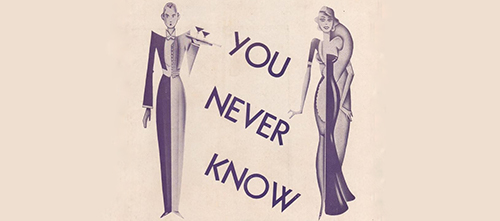
Musical
Musique: Cole Porter • Robert Katscher • Paroles: Cole Porter • Livret: Rowland Leigh • Production originale: 1 version mentionnée
Dispo: Résumé Commentaire Génèse Liste chansons
You Never Know is a musical with a book by Rowland Leigh, adapted from the original European play By Candlelight, by Siegfried Geyer and Karl Farkas, with music by Cole Porter and Robert Katscher, lyrics by Cole Porter, additional lyrics by Leigh and Edwin Gilbert, directed by Leigh, and songs by others.
The show was written not long after the riding accident that left Porter semi-crippled, and is considered one of the flops he wrote before his return to prominence with Kiss Me, Kate.[1]
Genèse: The show was first produced in Europe with a small cast, but the Shubert Brothers (who produced it for Broadway), did not want to produce it with no chorus or large stage numbers. They hired Porter and other composers to write extra material, and when it premiered on Broadway in 1938 it was no longer a chamber musical, but a typical 1930s "big musical".
Original Broadway cast
Produced by John Shubert, the Broadway production, opened on September 21, 1938 at the Winter Garden Theatre, where it ran for 78 performances, after tryouts in New Haven, Boston, Washington, Philadelphia, Chicago, and Indianapolis, among others. The cast featured Clifton Webb, Lupe Vélez, Libby Holman, Toby Wing (later replaced by June Havoc), and Rex O'Malley.
Later productions
It was staged Off-Broadway at the Eastside Playhouse from March 12 to March 18, 1973, lasting only 8 performances. The show was directed and production design by Robert Troie and musically directed by Walter Geismar. The show starred Esteban Chalbaud, Lynn Fitzpatrick, Dan Held, Rod Loomis, Grace Theveny, and Jamie Thomas.[4] The number Greek To You, They All Fall In Love, and You've Got That Thing was added.
In 1975, there was a regional production of the show put on in Ogunquit, Maine at the Ogunquit Playhouse from August 4 to August 9. The show starred Bob Wright, Kitty Carlisle, Joe Masiell, and Bernice Massi.[6][7] This production added Porter numbers from other works, including the songs After You, Who? (Gay Divorce), Greek To You (Greek To You), It Must Be Fun To Be You (cut from Mexican Hayride), Waltz Down The Aisle (Ever Yours), What A Fair Thing Is A Woman (cut from Can Can), What Does Your Servant Dream About? (cut from Kiss Me, Kate), and Who Knows? (Rosalie).
May 26, 1991 was the opening night of You Never Know at the Pasadena Playhouse in Pasadena, California. The show was directed by Paul Lazarus, musical director John McDaniel, set design James Leonard Joy, lighting design Martin Aronstein, costume design Reve Richards, sound design Jack Allaway, choreography by Thommie Walsh, and musical supervision, arrangements, and orchestrations Steve Orich. The show starred David Garrison (Gaston), Harry Groener (Baron), Kurt Knudson (Herr Baltin), Donna McKechnie (Baltin), Megan Mullally (Maria), and Angela Teek (Ida).
There was an Off-Broadway revival in 1996 at the Paper Mill Playhouse. The show was directed by Charles Repole, set design Michael Anania, costumes by Gregg Barnes, lighting Tom Sturge, sound David R. Paterson, music direction John Mulcahy, and choreography by Michael Lichtefeld. The show starred Stephanie Douglas (Maria), Nancy Hess (Baltin), Tom Ligon (Herr Baltin), Michael O'Steen (Gaston), John Scherer (Baron), and KT Sullivan (Ida).
It had a limited run from April 14–24, 2009 at the McGinn/Cazale Theatre. The show was directed by Thomas Sabella-Mills, lighting design Yingzhi Zhang, musical direction by James Stenborg. The show starred James Zanelli (Baron), Kevin Kraft (Gaston), Kate Marilley (Baltin), Jennifer Evans (Maria), Christy Morton (Ida), Bill Coyne (Waiter), and Todd Faulkner (Herr Baltin).
Résumé: Maria, maid to Mme. Baltin, impersonates her mistress while carrying out an assignation with the Baron de Romer's valet, Gaston, whom she believes to be the Baron himself. The Baron discovers the pair, but, being a good sport, he assumes the role of his servant in order to assist Gaston in his romantic pursuit. When Mme. Baltin discovers her maid's deceit, she is less of a good sport and exposes the masquerade. All ends happily, though, as the foursome sup by candlelight. Other characters include the Baron's gregarious friend Ida Courtney and Mme. Baltin's cheating husband, Henri, the dry goods king of France.
Principales versions:
1. Winter Garden Theatre (Londres-Angleterre)
21/09/1938 26/11/1938
78 représ.
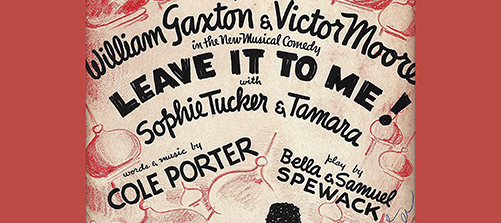
Musical
Musique: Cole Porter • Paroles: Cole Porter • Livret: Bella Spewack • Samuel Spewack • Production originale: 1 version mentionnée
Dispo: Résumé Génèse Liste chansons
Leave It to Me! is a 1938 musical with music and lyrics by Cole Porter. The book was a collaborative effort by Samuel and Bella Spewack, who also directed the Broadway production. The musical was based on the play Clear All Wires by the Spewacks, which was performed on Broadway for 93 performances in 1932, and which was filmed in 1933, starring Lee Tracy, Benita Hume, Una Merkel and James Gleason.
Set in Stalinist Russia in the 1930s, with Stalin himself appearing at the end, in the Cold War era after World War II its comic treatment of Soviets and Nazis seemed misplaced, and the show was not revived until the late 1980s.
Mary Martin made her Broadway debut in this musical, which introduced the songs "Get Out of Town" and "My Heart Belongs to Daddy."
Genèse: Productions
The musical had pre-Broadway tryouts at the Shubert Theatre, New Haven, starting on October 13, 1938 and then at the Shubert Theatre, Boston, starting on October 17, 1938.
It opened on Broadway at the Imperial Theatre on November 9, 1938 and closed on July 15, 1939 after 291 performances. It reopened on September 4, 1939 and closed September 16, 1939 for another 16 performances. The choreography was by Robert Alton, costumes by Raoul Pene du Bois, set by Albert Johnson, and Ernest K. Gann was the General Manager. The cast featured William Gaxton, Victor Moore, Sophie Tucker, Mary Martin, Tamara Drasin, and Alexander Asro. In his first Broadway show, Gene Kelly had a role as a dancer and Secretary to Mr. Goodhue. The original production ended with the appearance of Joseph Stalin, who led a final dance to the Soviet anthem The Internationale. After the signing of the Nazi-Soviet pact, Stalin was dropped from the show.
The Equity Library Theater in New York City presented a revival of the show – the first time it was revived in the United States – in March 1988. The "Musicals Tonight!" series, New York City, held a staged concert in March 2001. 42nd Street Moon Theatre Company, San Francisco, presented the musical in November–December 2001.
Résumé: In the late 1930s, aging businessman Alonzo "Stinky" Goodhue has become the American ambassador to the Soviet Union. The job was secured for him by his social-climbing wife, Leora, who helped to fund Franklin Roosevelt's re-election campaign. However, "Stinky" has no desire to live in Stalinist Russia. He is longing for the pleasures of his home in Topeka, Kansas, especially banana splits. He hopes his tenure as ambassador will be a short one. Meanwhile, an ambitious newspaper reporter, Buckley J. "Buck" Thomas, is employed to discredit Goodhue by his publisher who wants to be the ambassador himself. When Thomas and Goodhue realise they both have the same aims, they work together.
Goodhue plans to make major diplomatic gaffes, which will be publicised by Thomas. He delivers an inflammatory speech, but is hailed for his courage. He kicks the Ambassador of Nazi Germany, to the delight of the Soviets. He then attempts to shoot a Soviet official, but hits a counter-revolutionary aristocrat instead. Each time he ends up being hailed as a hero (in a parody of diplomatic speak, the British ambassador says "Britain views your deed [kicking the Nazi] with pride and alarm, congratulates and condemns you, and will now perform its breathtaking triple loop, suspended by a single wire, sitting in a tub of water."). His recall seems further away than ever.
In a subplot, Buck Thomas is involved with his boss's "protégée", the free-spirited Dolly Winslow. He falls in love with Colette, one of Goodhue's daughters. He has to extract himself from Dolly to win Colette. Dolly eventually finds herself stranded at a railroad station in Siberia. She slowly takes off her furs to admirers as she sings of her flirtations, but insists "My Heart Belongs to Daddy", referring to her "sweet millionaire" sugar-daddy.
The ambassador finally resolves to give up his tricks and tries to promote good relations between the United States and the Soviet Union; however his sincere attempts to improve matters now go disastrously wrong. He finally gets his wish to be recalled back to Topeka.
Principales versions:
1. Imperial Theatre (Broadway-Etats-Unis)
09/11/1938 16/09/1939
307 représ.
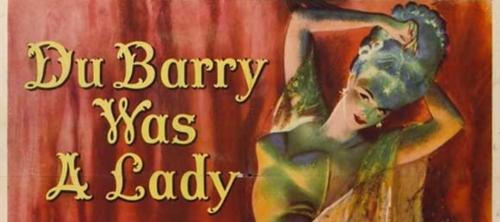
Musical
Musique: Cole Porter • Paroles: Cole Porter • Livret: B.G. DeSylva • Herbert Fields • Production originale: 3 versions mentionnées
Dispo: Résumé Génèse Liste chansons
Le Du Barry Was a Lady de Cole Porter est l’un des plus grands succès de l’époque. Ce spectacle flamboyant a été créé avec Bert Lahr et Ethel Merman en tête d'affiche, des nombreux et somptueux costumes de Raoul Pene du Bois et contenant au moins six ballets majeurs chorégraphiés par Robert Alton. Les blagues étaient parfois un peu risquées, et au moins deux des chansons de Porter (It Ain’t Etiquette et But in the Morning, No!) ont été jugées trop «inappropriées» pour la radio. Et trois chansons sont devenues des standards: la belle ballade Do I Love You? (pour Ronald Graham); le duo Friendship (pour Lahr et Merman); et le Well, Did You Evah! (pour Betty Grable et Charles Walters). Le musical a tenu l'affiche pendant plus d’un an, et a été le dernier musical à ouvrir à Broadway dans les années '30.
Genèse: 1939 Broadway
Le musical a ouvert à Broadway au 46th Street Theatre le 6 décembre 1939. Le spectacle sera transféré au Royale Theatre le 21 octobre 1940 et fermera le 12 décembre 1940, après 408 représentations. Il a été mis en scène par Edgar MacGregor, chorégraphié par Robert Alton, avec les orchestrations de Robert Russell Bennett et Ted Royal. La distribution présentait Bert Lahr (Louis Blore), Ethel Merman (May Daly), Betty Grable (Alice Barton), Benny Baker (Charley), Ronald Graham (Alex Barton) et Charles Walters (Harry Norton). Gypsy Rose Lee et Francis Williams reprendront plus tard joué le rôle de May Daly.
1942 West End
Le spectacle a ouvert dans le West End au His Majesty’s Theatre le 22 octobre 1942 pour 178 représentations. Il a été mis en scène par Richard Bird. La distribution mettait en vedette Arthur Riscoe (Louis Blore), Frances Day (May Daly), Frances Marsden (Alice Barton), Jacky Hunter (Charley), Bruce Trent (Alex Barton) et Teddy Beaumont (Harry Norton).
Productions suivantes
Le spectacle a été présenté en concert à plusieurs reprises, aux États-Unis et au Royaume-Uni. Les deux productions britanniques, en 1993 et 2001, étaient présentées par la «Discovering Lost Musicals Charitable Trust» avec Louise Gold comme May Daly et Barry Cryer comme Louis en 1993 et Desmond Barrit en 2001. La production de mai 1993 s'est jouée au Barbican Centre. Le concert de novembre 2001 a été présentée (comme la production originale de Londres) au Her Majesty’s Theatre, enregistré pour la radio par la BBC (il a été diffusé sur BBC Radio 3 pour Noël 2002).
Le New York City Center Encores! a présenté un concert en février 1996 avec Robert Morse (Louis) et Faith Prince (mai).
The show has been produced in concert form several times, in both the US and the UK. The two UK productions, in 1993 and 2001, were by the "Discovering Lost Musicals Charitable Trust" and featured Louise Gold as "May Daly" with Barry Cryer as Louis in 1993 and Desmond Barrit in 2001. The May 1993 production was at the Barbican Centre. The November 2001 concert was (like the original London production) at Her Majesty's Theatre, recorded for radio by the BBC (it was broadcast on BBC Radio 3 during Christmas 2002).
Le New York City Center Encores! a présenté un concert en février 1996 avec Robert Morse (Louis) et Faith Prince (May).
Résumé: Un préposé aux toilettes, Louis Blore, gagne à la Loterie et démissionne de son boulot. Il est amoureux de la chanteuse de discothèque May Daly, mais elle est elle-même amoureuse d’Alex Barton. Alex est le frère de son amie Alice, qui est amoureuse de Harry Norton. Pendant ce temps, Alex est marié à Ann, un mariage malheureux.
Charley, le remplaçant de Louis, suggère que Louis glisse un Mickey Finn [boisson alcoolisée dans laquelle on a versé une drogue à l'insu de celui qui la consomme] à Alex. En essayant de le faire, Louis boit par inadvertance le Mickey Finn, s’endort, et rêve qu’il est le roi Louis XV de France, et que May est Madame du Barry. Dans son rêve, Charley devient le Dauphin (plus tard Louis XVI) et Harry devient le capitaine de la garde, avec Ann comme dame d’honneur de Du Barry, et Alex comme paysan qui a écrit une chanson grossière sur Le Roi et Du Barry (la chanson titre : Du Barry was a Lady).
Finalement, après divers enchevêtrements (dont le Dauphin tirant sur le Roi dans le postérieur avec un arc et une flèche), Louis se réveille et réalise qu’Alex est l’homme de May. Il utilise le dernier de ses gains pour payer le divorce d’Alex avec Ann, et (avec Charley qui vient de quitter son emploi) revient à être un préposé aux toilettes.
Principales versions:
1. Richard Rodgers Theatre (Broadway-Etats-Unis)
06/12/1939 12/12/1940
408 représ.
2. Her Majesty's Theatre (Londres-Angleterre)
22/10/1942 //
178 représ.
3. *** Film (***-***)
13/08/1943 //
représ.
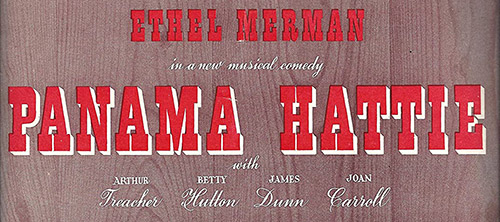
Musical
Musique: Cole Porter • Paroles: Cole Porter • Livret: B.G. DeSylva • Herbert Fields • Production originale: 2 versions mentionnées
Dispo: Résumé Liste chansons
Résumé:
Acte I
Hattie Maloney owns a night club in the Panama Canal Zone where she also performs. Three sailors from the S.S. Idaho, Skat Briggs, Windy Deegan and Woozy Hoga, ask her to sing at a party they are organizing ("Join It Right Away"). Nick Bullet, Hattie’s fiance, is a wealthy Navy officer. They are about to meet his eight-year-old daughter Geraldine (Jerry), off the boat from Philadelphia. He tells Hattie, "My Mother Would Love You". Hattie, eager to make a good impression on her prospective stepdaughter, spends three weeks' wages on her elaborately frilly outfit. But when she arrives, Jerry makes fun of Hattie's clothing and way of speaking. Feeling that her marriage is off, Hattie gets drunk on rum ("I’ve still Got my Health"). Kitty-Belle, the daughter of Admiral Whitney Randolph, wants to marry Nick, and she schemes to end his romance with Hattie.Florrie, a singer in the night club, develops a crush on Nick's very proper butler Vivian Budd ("Fresh as a Daisy"). Nick’s efforts to persuade Jerry and Hattie to get along with each other finally succeed, with Jerry making the still hungover Hattie cut the bows off her dress and shoes ("Let’s Be Buddies"). Jerry gives Hattie advice on how to behave like a lady at a party where she is to be presented to Nick’s boss, the Admiral ("I’m Throwing a Ball Tonight"). Admiral Randolph is to be presented with a cup, and his daughter Kitty-Belle suggests that Hattie might present it filled with goldenrod. This gives Whitney hay fever; Hattie is blamed, and Nick is ordered not to marry Hattie.
Acte II
The sailors from the S. S. Idaho uncover a spy plot involving saboteurs. Hattie swears off rum ("Make It Another Old Fashioned Please"). Hattie has it out with Kitty-Belle, whose boyfriend keeps being called in whenever Hattie is on the verge of hitting her. Meanwhile, Florrie continues to try to attract the romantic attention of Budd ("All I’ve Got to Get Now is My Man"). Hattie, two of the sailors and Budd meet regarding these various threads ("You Said It"). Mildred Hunter, Kitty-Belle’s best friend, turns out to be a terrorist ("Who would Have Dreamed"). She gives Jerry a secret package to put in Nick’s desk. Hattie overhears the plot to blow up the Panama Canal control room, finds the bomb and throws it out, saving the day. The grateful Admiral Whitney retracts his order and the sailors praise Hattie ("God Bless the Woman").Principales versions:
1. Richard Rodgers Theatre (Broadway-Etats-Unis)
30/10/1940 03/01/1942
501 représ.
2. Piccadilly Theatre (Londres-Angleterre)
04/11/1943 //
308 représ.
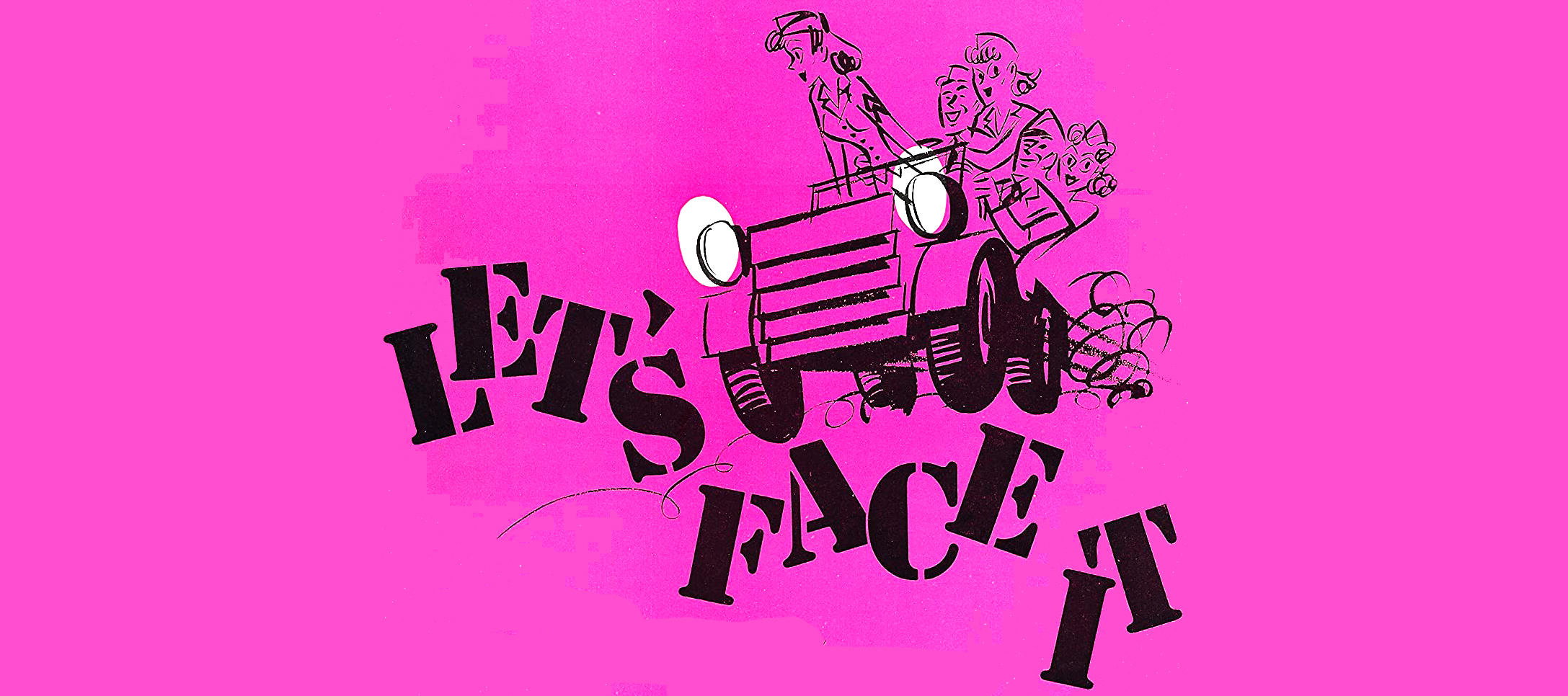
Musical
Musique: Cole Porter • Paroles: Cole Porter • Livret: Dorothy Fields • Herbert Fields • Production originale: 3 versions mentionnées
Dispo: Résumé Génèse Isnpiration Liste chansons
Let’s Face It est un musical avec une musique et des paroles de Cole Porter. Le livret de Herbert et Dorothy Fields est basé sur la pièce de 1925 The Cradle Snatchers de Russell Medcraft et Norma Mitchell.
Genèse: 1941 – Création à Broadway
La production originale est a été mise en scène par Edgar MacGregor et chorégraphiée par Charles Walters. Après un Try-Out au Colonial Theatre de Boston, le musical a ouvert à Broadway à l'Imperial Theatre le 29 octobre 1941 et a fermé le 20 mars 1943, après 547 représentations. La distribution comprenait Danny Kaye (Jerry Walker), Eve Arden (Maggie Watson), Edith Meiser (Cornelia Abigail Pigeon), Vivian Vance (Nancy Collister), Benny Baker, Mary Jane Walsh (Winnie Potter) et Nanette Fabray. La distribution comprenait aussi Carol Channing encore totalement inconnue comme understudy d’Eve Arden. Danny Kaye avait fait ses débuts réussis plus tôt dans l’année dans Lady in the Dark(), et Porter a permis à la femme de l’acteur, Sylvia Fine, d’ajouter deux numéros comiques dans la partition pour qu’il chanterait. Plus tard dans la série, Carol Goodner a remplacé Eve Arden et José Ferrer a remplacé Kaye.
1942 – Création à Londres
Les Try-Out au Royaume-Uni ont commencé le 23 juin 1942 au Palace Theatre de Manchester. La production du West End a ouvert le 19 novembre 1942 à l'Hippodrome Theatre où elle s'est jouée durant 348 représentations. Le spectacle a été mis en scène par Bobby Howell et chorégraphié par Joan Davis. La distribution comprenait Bobby Howes (Jerry Walker) et Pat Kirkwood (Winnie Potter).
Résumé: Méfiantes des voyages de chasse de leurs maris, Maggie Watson, Nancy Collister et Cornelia Pigeon décident de renverser la vapeur et d’inviter trois jeunes militaires à la maison d’été de Maggie à Southampton. Les copines de ces trois jeunes militaires apprennent l'existence de ce stratagème et décident de faire échouer la fête. Pour rajouter quelques complications, les maris retournent aussi chez eux.
Principales versions:
1. Imperial Theatre (Broadway-Etats-Unis)
29/10/1941 20/03/1943
547 représ.
2. Hippodrome (The) (Londres-Angleterre)
19/11/1942 //
348 représ.
3. *** Film (***-***)
05/08/1943 //
représ.
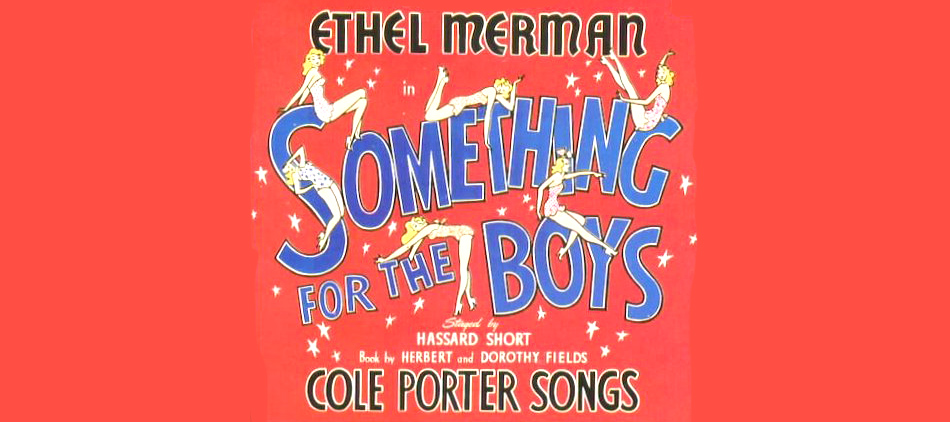
Musical
Musique: Cole Porter • Paroles: Cole Porter • Livret: Dorothy Fields • Herbert Fields • Production originale: 2 versions mentionnées
Dispo: Résumé Liste chansons
Connu pendant la préparation sour le titre Jenny, Get Your Gun, le musical Something for the Boys de Cole Porter fut un succès populaire et critique qui a duré un an et a marqué la cinquième et dernière apparition d’Ethel Merman dans un musical de Porter. La production somptueuse de Michael Todd offrait un complot léger lié à la guerre qui impliquait des soldats, leurs femmes et leurs petites amies, des usines de défense et même la nouveauté d’une «arme» secrète pour gagner la guerre.
Résumé: L'histoire suit trois cousins, Blossom (Ethel Merman), Chiquita (Paula Laurence) et Harry (Allen Jenkins), ne se connaissant pas du tout, qui héritent ensemble d’un immense domaine au Texas situé à côté d’une base militaire.
Les trois cousins transforment la maison délabrée en une pension pour les femmes des militaires ainsi qu’une sorte d’usine de défense dans laquelle les femmes fabriquent des pièces d’avion. Blossom et le soldat Rocky Fulton (Bill Johnson) tombent amoureux, mais la jalouse Melanie Walker (Frances Mercer) tente de briser la romance en suggérant aux responsables de l’armée que le pensionnat est un autre type de maison.
Mais comme à cette époque tout est possible dans les livrets de musicals à Broadway, il semble qu'une des dents de Blossom agisse comme un émetteur radio, et donc l’armée, peut se rendre compte que les activités sur le domaine sont innocents. Blossom suggère que les dents des soldats soient équipées de la même manière pour qu’ils puissent devenir leurs propres émetteurs radio pendant la guerre!!!
Dietz, Dan. The Complete Book of 1940 Broadway Musicals. Rowman & Littlefield Publishers. Édition du Kindle.
Principales versions:
1. Neil Simon Theatre (Broadway-Etats-Unis)
07/01/1943 08/01/1944
422 représ.
2. Coliseum Theatre (Londres-Angleterre)
30/03/1944 20/05/1944
représ.
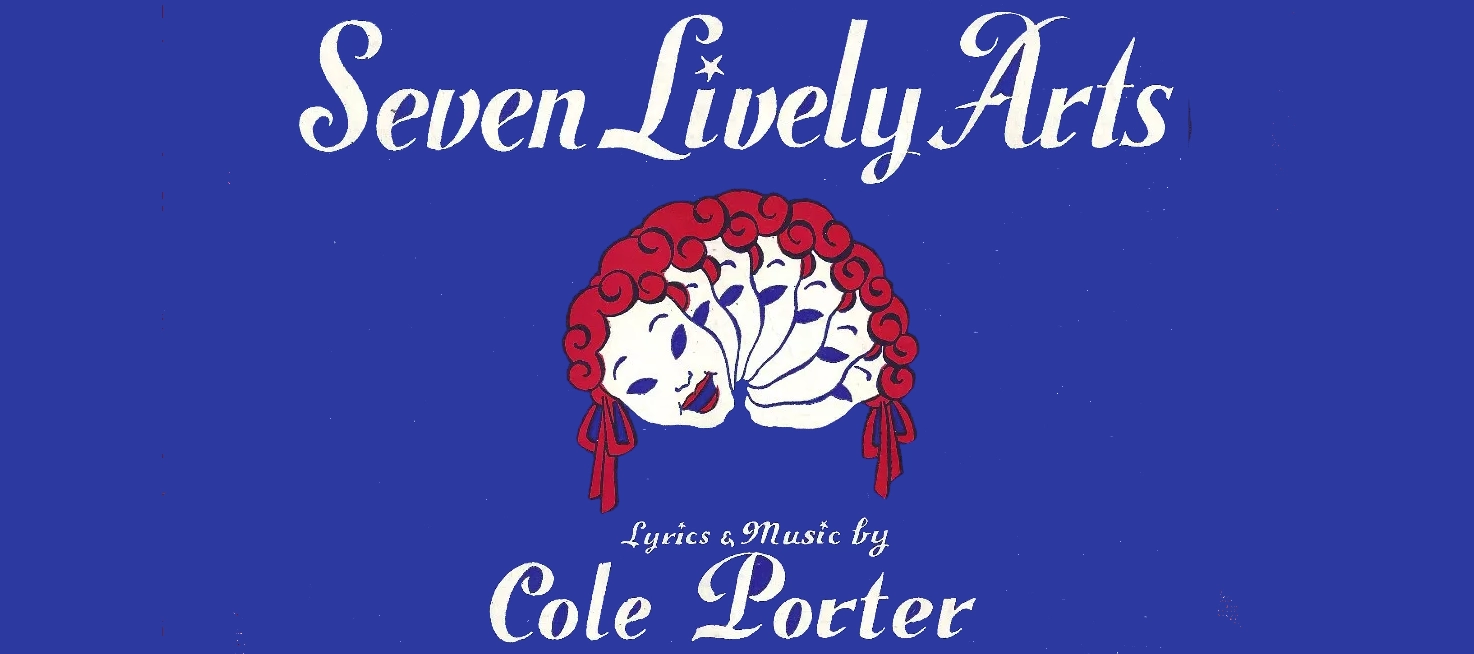
Revue
Musique: Cole Porter • Paroles: Cole Porter • Livret: Charles Sherman • George S. Kaufman • Moss Hart • Production originale: 1 version mentionnée
Dispo: Génèse Liste chansons
Cette revue est un des gros échecs de Cole Porter. Ce qui se voulait au départ un "book musical" et qui avait migré vers une simple "revue" dotée d'un vague fil rouge. Même si elle a inuaguré à grands renforts de publicité la réouverture du Ziegfeld Theatre totalement rénové par son nouveai propriétaiere, Billy Rose, elle ne tint l'affiche que 183 représentations.
Genèse: La production par Billy Rose de Seven Lively Arts a été l’une des plus impressionnantes de la décennie. Billy Rose avait acheté le Ziegfeld Theatre et l’avait totalement rénové. La revue Seven Lively Arts fut la première production à y jouer sous sa propriété. Les billets pour la soirée d’ouverture coûtaient 24$ chacun (somme énorme pour l’époque, environ 500€ d’aujourd’hui), alors que personne n’en avait entendu parler à l’époque, et pendant l’entracte, on offrait du champagne au public. Dans le hall inférieur du théâtre, on pouvait voir sept peintures spécialement commandées à Salvador Dali qui représentaient sa «conception surréaliste» des sept arts vivants. On a estimé que l’achat du théâtre lui-même, sa rénovation et le coût de la revue s’élevaient à deux millions de dollars. La revue proposait de nouveaux sketchs de Moss Hart et George S. Kaufman (chacun écrivant les siens séparément, sans collaboration) et des chansons de Cole Porter (et avec une musique originale pour ballet d’Igor Stravinsky). La revue était interprétée par Beatrice Lillie, Bert Lahr et Benny Goodman, et on pouvait y remarquer aussi Dolores Gray et Bill (William) Tabbert.
À l’origine, le spectacle devait être un «book musical» - un musical doté d’un livret - qui traitait de sept jeunes espoirs se rendant à New York à la recherche de la renommée dans les sept domaines des arts: peinture (Nan Wynn), claquettes (Jere McMahon), chant radio (Paula Bane), danse classique (Billie Worth), l’écriture de pièces (Bill Tabbert), le cinéma (Dolores Gray) et l’interprétation scénique (Mary Roche). Le concept fut vite abandonné et le spectacle évolua vers la revue, mais le point de départ des sept jeunes espoirs fut retenu pour l’ouverture (la chanson Big Town) et la clôture (la séquence générale intitulée They All Made Good). Et tout au long de la soirée, ces sept artistes participaient à la plupart des chansons et des ballets. À la fin de la série, la séquence de fermeture avait été abandonnée. Et quand Dolores Gray a quitté la production, elle n’a pas été remplacée pendant une longue période et donc pendant un certain temps il y avait seulement six espoirs; et ainsi le trio Wow-ooh-wolf! pour Wynn, Gray et Roche est devenu un duo pourWynn et Roche. Quand Benny Goodman a quitté la production, il a été remplacé par The Cozy Cole Quintet. Tout au long de la soirée, Doc Rockwell incarnait une sorte de maître de cérémonie avec des moments d’humour.
Les critiques ont convenu que la performance étincelante de Beatrice Lillie était le meilleur de la revue, et ses sketches (tous de Moss Hart) étaient le top de la soirée. Dans There'll Always Be an England, elle a incarne Lady Agatha, une vieille fille britannique totalement stupide, qui visite le réfectoire dans une caserne de militaires américains; elle s’est préparée en faisant une étude attentive du jargon utilisé par les soldats américains et elle tente d’être "l’un de ces boys " en utilisant leur argot. Mais elle ne réalise pas que les expressions qu’elle utilise, ne signifient pas ce qu’elle pense… Il y a en fait des tas d’insinuations sexuelles – dont elle ne se rend pas compte – et qui laisse les jeunes soldats américains en état de choc, pour ne pas dire autre chose. Dans Ticket for the Ballet, elle joue un autre personnage stupide: une cliente faisant la queue pour acheter un billet pour un ballet. Elle ne connait pas grand-chose sur la danse, mais affirme que le ballet S. Hurok est intéressant à voir…
Malheureusement, le spectacle n’a pas été bien accueilli de manière par le public, et beaucoup des artistes ayant participé à sa création ont plus tard souvent presque passé sous silence leur participation au spectacle. Pour Cole Porter, Seven Lively Arts fut un des pires échecs de toute sa carrière professionnelle. Ce qui aurait pu être un succès dix ans auparavant, tenait difficilement l’affiche à côté d’Oklahoma!
Principales versions:
1. Ziegfield Theatre (Broadway-Etats-Unis)
07/12/1944 12/05/1945
183 représ.

Musical
Musique: Cole Porter • Paroles: Cole Porter • Livret: Orson Welles • Production originale: 1 version mentionnée
Dispo: Résumé Génèse Isnpiration
Around the World qui est un projet porté par Orson Welles. Après avoir terminé le tournage de son film de 1946, The Stranger, Welles a décidé de créer un musical à partir de l’un de ses livres d’enfance préférés, Le Tour du Monde en Quatre-Vingts jours de Jules Verne. Ce devait être le musical de ses rêves avec un cirque sur scène, un train traversant l’Ouest et d’autres idées de production extravagantes. Les chansons et musiques de scène sont signées de Cole Porter. Le spectacle a été un gouffre financier et a dû s'arrêter au bout de 75 représentations. Orson Welles devra rembourser ses dettes pendant des années…
Genèse: Orson Welles a levé des fonds auprès de Mike Todd, du producteur William Goetz et d’Alexander Korda, qui détenait les droits européens du titre. Cependant, la scénographie extravagante ne lui laissait plus d’argent pour engager une distribution de stars et a choisi des artistes peu connus. De plus, selon le biographe critique de Welles, Charles Higham: «Cole Porter a écrit les chansons beaucoup trop rapidement et mal».
Le spectacle avait une distribution de 70 artistes et comprenait quatre éléphants mécaniques et 54 machinistes!!! Lorsque Mike Todd, effrayé, s’est retiré de la production, Welles a engagé son propre argent. Il a également emprunté de l’argent au président de Columbia Pictures, Harry Cohn, lui promettant en échange d’écrire, de produire, de réaliser et de jouer dans un film pour Cohn sans frais. Ce sera le film de 1947 La Dame de Shanghai.
Le dramaturge John van Druten a décrit le musical comme «extrêmement amusant» et Joshua Logan a déclaré qu’il était «frais, spirituel, magique, excitant». Cependant, sans histoire et avec des relations peu claires entre les personnages, la série s’est terminée rapidement, Welles perdant ses économies et les investisseurs perdant de «grosses sommes».
Around the World est donc un musical produit par la société Mercury Productions d’Orson Welles. Il a débuté ses try-out à l’Opéra de Boston, à Boston, le 28 avril 1946. Il a ensuite déménagé au Shubert Theatre de New Haven le 7 mai puis au Shubert Theatre de Philadelphie le 14 mai. La première a eu lieu à Broadway à l’Adelphi Theatre le 31 mai 1946 et le musical a fermé ses portes le 3 août 1946 après 75 représentations seulement.
Il a été mis en scène par Welles avec des séquences de cirque créées par Barbette, une chorégraphie de Nelson Barclift, des costumes d’Alvin Colt, des décors de Robert Davison et des éclairages de Peggy Clark. Il y avait 38 décors, que Welles a demandé à être conçus dans le style des films de Georges Méliès.
Un tel spectacle ne s’improvise pas, d’où les trois séries de try-out. Les problèmes techniques avaient été en grande partie résolus avant l’ouverture à New York. Welles a joué divers rôles tout au long de la pièce, et une fois il a même dû jouer un soir le rôle principal. Le dernier soir du premier try-out (Boston), quand Arthur Margetson a perdu sa voix, Welles a lu le rôle de Fogg et une doublure a chanté les chansons. «Le public a eu l’impression de participer à une série bénie», a écrit le biographe David Thomson. «C’était une soirée envoûtante, avec Welles qui a parlé à tout le monde, y compris au public.»
Bien que le public ait apprécié Around the World, ses finances précaires et la climatisation inadéquate du théâtre n’ont pas pu le soutenir pendant l’été, et Welles a été contraint de le fermer. Il a personnellement perdu environ 320.000$ (équivalent de 5 000 000 $ aujourd’hui). Il lui a fallu de nombreuses années pour payer la dette.
Après l’échec du spectacle à Broadway, Welles tenait à le mettre en scène à Londres, où Alexander Korda avait prédit qu’il serait un grand succès, mais les règles syndicales britanniques interdisaient l’importation d’accessoires et de décors fabriqués lors de la production américaine, et ils ont dû être détruits. Ils se sont avérés trop coûteux à reconstruire, et le spectacle n’a plus jamais été joué en version scénique.
Résumé: « Wellesapoppin" est la manière dont Variety a résumé l’adaptation théâtrale du roman de Jules Verne, Autour du monde en quatre-vingts jours, par Orson Welles. Et c’était une description parfaite! Le musical se vantait d’être l’une des plus grandes productions de l’époque. Welles a tout mis en œuvre pour faire adapter le roman fantaisiste à la scène musicale sans l’édulcorer ou le diminuer: des décors amovibles, des écrans de projection (très rare à l’époque), des rideaux et même une scène secondaire (qui avait été construite sur la scène principale) ont servi à raconter l’histoire. Et parfois, l’action se déplaçait dans l’auditorium où des soldats des Marines américains défilaient dans les allées sur le son de "L’Hymne des Marines" pendant que Welles effectuait des tours de magie (il faisait apparaitre un canard dans la poche d’un spectateur, et Howard Barnes dans le New York Herald Tribune a rapporté que ni le canard ni le spectateur ne trouvaient cela drôle!).
Mais ce n’était pas tout. Il y avait un énorme éléphant en papier mâché et un gigantesque aigle volant en peluche qui emportait un membre de la distribution dans les airs depuis la scène vers les coulisses. Il y avait même des films muets (filmés par Welles spécialement pour le musical) qui dépeignaient les voyages de Fogg, sans parler d’une parodie de mélodrames anciens, de clowns, de jongleurs, de contorsionnistes, d’équilibristes, d’acrobates, de funambules et d’autres tours de magie. Il y avait des armes à feu explosives, des charmeurs de serpents, un fakir, une princesse indienne, des Chinois sinistres, des Indiens du Far West et un cirque japonais (ce cirque clôturait le premier acte).
En suivant Phileas Fogg, le public voyageait de Londres en Arabie et en Égypte – sans oublier le canal de Suez – puis en Inde, dans l’Himalaya, les mers de Chine, Hong Kong, le Japon, le nord du Mexique, San Francisco, les montagnes rocheuses, puis de retour à Londres. Et en chemin, il visitait des fumeries d’opium, empruntait des pagodes sur des canaux, traversait des forêts, la haute mer, des lacs, des marécages, des montagnes et … des maisons de débauche. Et comme si tout cela ne suffisait pas, il y avait des chansons de Cole Porter. Une courte partition à coup sûr (huit chansons seulement, mais aussi de la musique de ballet et de la musique de fond). Il faut se rappeler de « Pipe-Dreaming», du joyeux exultant «Look What I Found» et la chanson préférée des critiques, la sobre et belle ballade "Should I Tell You I Love You?" Dans l’ensemble, les critiques ont méprisé la partition de Porter.
Principales versions:
1. Adelphi Theatre (Broadway-Etats-Unis)
31/05/1946 03/08/1946
75 représ.
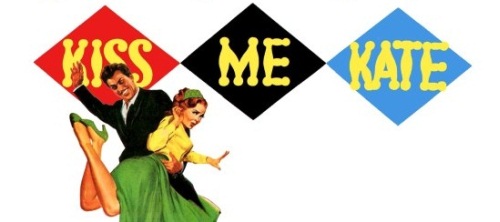
Musical
Musique: Cole Porter • Paroles: Cole Porter • Livret: Bella Spewack • Samuel Spewack • Production originale: 21 versions mentionnées
Dispo: Résumé Génèse Isnpiration Liste chansons
Kiss Me, Kate est un musical écrit par Bella et Samuel Spewack avec la musique et les paroles de Cole Porter. L'histoire suit la production d'une version musicale de The Taming of the Shrew (La Mégère apprivoisée) de William Shakespeare et le conflit qui en découle - sur et hors scène - entre Fred Graham, le metteur en scène, producteur et star du spectacle, et la first lady, son ex-femme Lilli Vanessi. Une histoire d'amour secondaire concerne Lois Lane, l'actrice qui joue Bianca, et son petit ami, le joueur Bill, qui est confronté à des gangsters. La production originale mettait en vedette Alfred Drake, Patricia Morison, Lisa Kirk et Harold Lang.
Kiss Me, Kate était la réponse de Porter à Oklahoma! () de Rodgers et Hammerstein et autres musicals intégrés; c'était le premier spectacle qu'il écrivait dans lequel la musique et les paroles étaient fermement liées au scénario. Le musical a été créé en 1948 et s'est avéré être le seul spectacle de Porter à avoir été présenté plus de 1.000 fois à Broadway .
Genèse: Le producteur Arnold Saint-Subber a eu l’idée de Kiss Me, Kate après avoir assisté aux violentes disputes – tant sur scène qu’hors scène – de deux monstres sacrés de la scène, les époux Alfred Lunt et Lynn Fontanne lors du revival de 1942 de La Mégère apprivoisée. En 1947, Saint-Subber a demandé à un autre couple d’artistes célèbres, Bella et Samuel Spewack (qui avaient eux-mêmes de lourds problème conjugaux à l’époque) d’écrire le livret; Bella Spewack a fait appel à Cole Porter pour écrire la musique et les paroles.
La partition de Porter est incroyablement diversifiée: elle s’inspire des styles musicaux de la Renaissance italienne, des opéras de Verdi, du blues, de la valse viennoise, … En écrivant les paroles de Kiss Me, Kate, Porter s’est inspiré des thèmes et de la langue shakespearienne, sans créer quelque chose d’ésotérique, et la chanson « Always True to You in My Fashion » a été inspirée par le poème d’Ernest Dowson « Non Sum Qualis Eram Bonae Sub Regno Cynarae », avec son refrain « I have been faithful to thee, Cynara, in my fashion ».
Et la partition contenait ce qui est sans-doute la chanson du Golden Age contenant le plus «de double-sens coquins» basé sur des jeux de mots sur les titres des œuvres de Shakespeare. Avec "Brush Up Your Shakespeare", Porter aborde la masculinité toxique. Porter s’est amusé à introduire les titres de quinze pièces et poèmes de Shakespeare, leur donnant pratiquement à tous un double-sens. Brooks Atkinson du New York Times a fait remarquer que certaines paroles de Porter "choqueraient les auteurs de la The Police Gazette».
Après un try-out de trois semaines au Shubert Theatre de Philadelphie à partir du 2 décembre 1948, la production originale de Broadway a ouvert le 30 décembre 1948 au New Century Theatre, où elle a été jouée pendant 19 mois avant d’être transférée au Shubert Theatre, pour un total de 1.077 représentations. Mis en scène par John C. Wilson avec une chorégraphie de Hanya Holm, la distribution originale comprenait Alfred Drake, Patricia Morison, Lisa Kirk, Harold Lang, Charles Wood et Harry Clark.
Cole Porter a écrit sa meilleure partition depuis des années, avec des paroles pleines d’esprit. Sous la direction de Hanya Holm, la danse est joyeuse. Et Lemuel Ayers a fourni des costumes de carnaval et des décors intéressants. »
La production a remporté 5 Tony Awards, dont celui du meilleur musical. L’enregistrement original de la distribution de 1949 a été repis au National Recording Registry de la Bibliothèque du Congrès pour « l’importance culturelle, artistique et/ou historique de l’album pour la société américaine et l’héritage audio de la nation ».
Résumé: Acte I
La distribution d’une version musicale de The Taming of the Shrew (La Mégère apprivoisée) de Shakespeare répète pour l’ouverture du spectacle en try-out ce soir-là (« Another Op’nin', Another Show »). L’égoïste Fred Graham est le metteur en scène et producteur du spectacle. Mais il joue aussi le rôle principal de Petruchio. Son ex-femme – une star de cinéma – Lilli Vanessi, joue le rôle principal féminin, Katherine. Ils semblent se disputer constamment, et Lilli, même si elle est son ex, est particulièrement en colère que Fred poursuive de ses ardeurs la jeune et sexy actrice Lois Lane, qui joue le rôle de Bianca. Après la répétition, le petit ami de Lois, Bill, apparaît. Il joue lui Lucentio, mais il a raté la répétition parce qu’il jouait ailleurs… Il lui annonce qu’il a signé une reconnaissance de dette de 10.000$ au nom de Fred, et Lois le réprimande («Why Can't You Behave?»).
Avant l’ouverture du soir, Fred et Lilli se croisent dans les coulisses, et Lilli montre sa bague de fiançailles que lui a offerte Harrison Howell, profitant de l’occasion pour rappeler à Fred que c’est l’anniversaire de leur divorce. Ils se souviennent de l’opérette dans laquelle ils se sont rencontrés, qui comprenait «Wunderbar», une valse viennoise. Ils finissent par se remémorer avec tendresse leurs souvenirs et se mettent à chanter et danser. Deux gangsters surgissent pour s’emparer de la reconnaissance de dette de 10.000$, et Fred répond qu’il ne l’a jamais signée. Les gangsters lui disent avec empressement qu’ils lui donnent le temps de s’en souvenir et qu’ils reviendront plus tard. Dans sa loge, Lilli reçoit des fleurs de Fred, et elle déclare qu’elle est toujours «tellement amoureuse» de lui. Fred essaie d’empêcher Lilli de lire la carte qui accompagne les fleurs, ce qui révèle qu’il les destinait en réalité à Lois. Cependant, Lilli emporte la carte avec elle sur scène, disant qu’elle la lirait plus tard.
Le spectacle commence (« We Open in Venice »). Baptista, le père de Katherine et Bianca, ne permettra pas à sa fille cadette Bianca de se marier tant que sa fille aînée Katherine ne sera pas mariée. Cependant, elle est rusée et de mauvaise humeur, et aucun homme ne désire l’épouser. Trois prétendants - Lucentio, Hortensio et Gremio - tentent de courtiser Bianca, et elle annonce qu’elle épouserait n’importe lequel d’entre eux (« Tom, Dick ou Harry »). Petruchio, un ami de Lucentio, exprime le désir de se marier avec quelqu’un de fortuné (« I've Come to Wive it Wealthily in Padua»). Les prétendants élaborent un plan pour qu’il épouse Kate, car Baptista est riche. Kate, cependant, n’a pas l’intention de se marier (« I Hate Men »). Petruchio tente de la courtiser (« Were Thine That Special Face »). Une fois sortie de scène, Lilli a l’occasion de lire la carte. Elle entre dans une colère mémorable quand elle comprend que le bouquet de Fred ne lui était pas destiné. Elle entre sur scène sans prévenir et commence à frapper Fred, qui, avec les autres acteurs, essaie de rester dans son personnage au moment même où Baptista donne à Petruchio la permission d’épouser Kate. Lilli continue de frapper Fred, et il finit par lui donner une gifle. En coulisses, Lilli annonce furieusement qu’elle quitte le spectacle. Cependant, les gangsters sont de retour, et Fred leur dit que si Lilli quitte le show, il devra arrêter le spectacle et ne pourra pas leur payer les 10.000 $. Sous la menace de leurs armes, les gangsters forcent Lilli à continuer le spectacle. De retour sur scène, Bianca et Lucentio dansent pendant que le chœur interprète « We Sing of Love », permettant un changement de décor. Le rideau s’ouvre, révélant l’extérieur d’une église; Petruchio et Kate viennent de se marier et sortent de l’église; les gangsters, vêtus de costumes shakespeariens, sont sur scène pour s’assurer que Lilli reste et joue son rôle. Petruchio implore Kate de l’embrasser, et elle refuse. Il la soulève par-dessus son épaule et la porte hors de la scène pendant qu’elle lui frappe le dos avec ses poings (« Kiss Me Kate »).
Acte II
Pendant l’entracte du spectacle, les acteurs et l’équipe se détendent dans la ruelle derrière le théâtre. Paul (l’assistant de Fred) et d’autres membres de l’équipe se plaignent qu’il fait « trop chaud » pour rencontrer leurs amants ce soir-là. La pièce continue, et Petruchio tente d'« apprivoiser » Katherine et pleure sa vie de célibataire maintenant perdue («Where Is the Life That Late I Led?»). En dehors de la scène, le fiancé de Lilli, Harrison Howell, est à la recherche de Lilli. Il tombe sur Lois, et elle le reconnaît comme un ancien amant (!!!) mais promet de ne pas le dire à Lilli. Bill est choqué d’entendre cela, mais Lois lui dit que même si elle est impliquée avec d’autres hommes, elle lui est fidèle à sa manière (« Always True to You in My Fashion »). Lilli essaie d’expliquer à Howell qu’elle est forcée de rester au théâtre par les gangsters, mais Howell ne la croit pas et veut discuter des projets de mariage. Fred souligne insidieusement à quel point la vie de Lilli avec Howell sera ennuyeuse par rapport au théâtre. Bill chante une chanson d’amour qu’il a écrite pour Lois (« Bianca »).
Les gangsters découvrent que leur chef a été tué, de sorte que la reconnaissance de dette n’est plus valide. Lilli s’en va, sans Howell, alors que Fred tente en vain de la persuader de rester (« So in Love » (Reprise)). Les gangsters se réfugient sur scène et improvisent un hommage à Shakespeare dans lequel ils expliquent que connaître Shakespeare est la clé de l’amour (« Brush Up Your Shakespeare »). La troupe se prépare pour la fin de la pièce, le mariage de Bianca et Lucentio, même s’il leur manque maintenant l’un des personnages principaux. Cependant, juste à temps pour le dernier discours de Katherine, Lilli arrive sur scène (« I Am Ashamed That Women Are So Simple»). Fred et Lilli se réconcilient sans un mot sur scène, et la pièce se termine (« Kiss Me Kate » (Finale)) avec eux, ainsi que Bill et Lois, s’embrassant passionnément.
Principales versions:
1. New Century Theatre (Broadway-Etats-Unis)
30/12/1948 28/07/1950
représ.
2. New Century Theatre (Broadway-Etats-Unis)
30/12/1948 18/07/1951
1077 représ.
3. Shubert Theatre (Boston-Etats-Unis)
31/07/1950 18/07/1951
représ.
4. Coliseum Theatre (Londres-Angleterre)
08/03/1951 23/02/1952
400 représ.
5. *** Film (***-***)
26/11/1953 //
représ.
6. New York City Center (Broadway-Etats-Unis)
08/05/1956 27/05/1956
23 représ.
7. *** TV (***-***)
20/11/1958 //
représ.
8. *** TV (***-***)
20/04/1964 //
représ.
9. *** TV (***-***)
25/03/1968 //
représ.
10. Coliseum Theatre (Londres-Angleterre)
23/12/1970 23/01/1971
représ.
11. Theater an der Wien (Vienne-Autriche)
09/02/1973 //
78 représ.
12. Old Vic (Londres-Angleterre)
08/05/1987 09/01/1988
représ.
13. Old Vic (Londres-Angleterre)
08/05/1987 13/08/1988
représ.
14. Savoy Theatre (Londres-Angleterre)
15/01/1988 13/08/1988
représ.
15. Open Air Theatre, Regent's Park (Londres-Angleterre)
22/07/1997 01/09/1997
représ.
16. Al Hirschfeld Theatre (Broadway-Etats-Unis)
25/10/1999 30/12/2001
881 représ.
17. Victoria Palace Theatre (Londres-Angleterre)
30/10/2001 24/08/2002
représ.
18. Old Vic (Londres-Angleterre)
20/11/2012 02/03/2013
représ.
19. Théâtre du Châtelet (Paris-France)
03/02/2016 12/02/2016
10 représ.
20. Coliseum Theatre (Londres-Angleterre)
20/06/2018 30/06/2018
représ.
21. Studio 54 (Broadway-Etats-Unis)
14/02/2019 02/06/2019
représ.
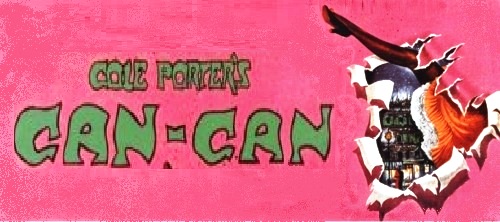
Musical
Musique: Cole Porter • Paroles: Cole Porter • Livret: Abe Burrows • Production originale: 13 versions mentionnées
Dispo: Résumé Synopsis Commentaire Génèse Liste chansons
Genèse: After the pre-Broadway tryout at the Shubert Theatre in Philadelphia in March 1953, Can-Can premiered on Broadway at the Shubert Theatre on May 7, 1953, and closed on June 25, 1955 after 892 performances. The original production, which Burrows also directed, starred Lilo as La Mome, Hans Conried as Boris, Peter Cookson as the judge, Gwen Verdon as Claudine, Dania Krupska, Phil Leeds, Dee Dee Wood, and Erik Rhodes as Hilaire. Michael Kidd was the choreographer. According to Ben Brantley, Claudine was "the part that made Gwen Verdon a star."
The West End production premiered at the Coliseum Theatre on October 14, 1954, and ran for 394 performances. Restaged by Jerome Whyte, the cast included Irene Hilda (La Mome), Edmund Hockridge (Aristide), Alfred Marks (Boris), Gillian Lynne (Claudine) and Warren Mitchell (Theophile).
A Broadway revival opened April 30, 1981 at the Minskoff Theatre and closed after five performances and sixteen previews. It was directed by Burrows with choreography by Roland Petit and starred Zizi Jeanmaire. Frank Rich wrote: "...mediocre material, no matter how it's sliced, is still mediocre material. 'Can-Can' never was a firstrate musical, and now, almost three decades after its original production, it stands on even shakier legs."
A 1983 outdoor production played at The Muny in St. Louis, starring Judy Kaye, John Reardon, John Schuck, Lawrence Leritz, Lorene Yarnell and Beth Leavel to excellent reviews.
The London revival at the Strand Theatre ran from October 26, 1988 through January 21, 1989. David Taylor directed, with choreography by Kenn Oldfield, with a cast that featured Donna McKechnie (Mme. Pistache), Bernard Alane, Norman Warwick, Janie Dee (Claudine) and Milo O'Shea. Producer Lovett Bickford explained that "his version was less a revival than a complete revision. 'For all intents and purposes, this is a new show,' he said."[6] It had a revised book which incorporated songs from Fifty Million Frenchmen, Nymph Errant, Silk Stockings, Out of This World and other Cole Porter musicals.
Also in 1988, an international tour starred Chita Rivera and Ron Holgate. The tour featured the Radio City Music Hall Rockettes. This production was directed by Dallett Norris, with choreography by Alan Johnson.[7]
In 2004, a City Center Encores! staged concert production featured Patti LuPone as La Mome Pistache, Michael Nouri (Judge Aristide Forestier), Charlotte d'Amboise (Claudine), Reg Rogers, and Eli Wallach. This production was directed by Lonny Price, with sets by John Lee Beatty and lighting by Kenneth Posner.
Résumé: Au tournant du siècle, à Paris, La Mome Pistache, fière propriétaire de l'infâme "Bal du Paradis", affronte Aristide Forestier, un juge extrêmement rigoureux qui a pour but de fermer tous les cabarets parisiens.
Par hasard, ils tombent amoureux et Aristide avoue qu'il n'y a obscénité que dans le fait de celui qui regarde…
Principales versions:
1. Forrest Theatre (Philadelphia-Etats-Unis)
// //
représ.
2. Shubert Theatre (Broadway-Etats-Unis)
// 25/06/1955
892 représ.
3. Coliseum Theatre (Londres-Angleterre)
// //
394 représ.
4. US Tour (-Etats-Unis)
// //
représ.
5. Paper Mill Playhouse (Milburn-Etats-Unis)
// //
représ.
6. *** Film (***-***)
09/03/1960 09/03/1960
représ.
7. Theater an der Wien (Vienne-Autriche)
02/03/1968 //
52 représ.
8. Minskoff Theatre (Broadway-Etats-Unis)
16/04/1981 03/05/1981
5 représ.
9. Novello Theatre (Londres-Angleterre)
// 21/01/1989
102 représ.
10. Takarazuka Grand Theatre (Takarazuka-Japon)
29/03/1996 06/05/1996
représ.
11. Takarazuka Theatre (Tokyo-Japon)
04/07/1996 30/07/1996
représ.
12. New-York City Center (New-York-Etats-Unis)
// 15/02/2004
5 représ.
13. Lilian Baylis Theatre (Londres-Angleterre)
// 28/04/2007
5 représ.
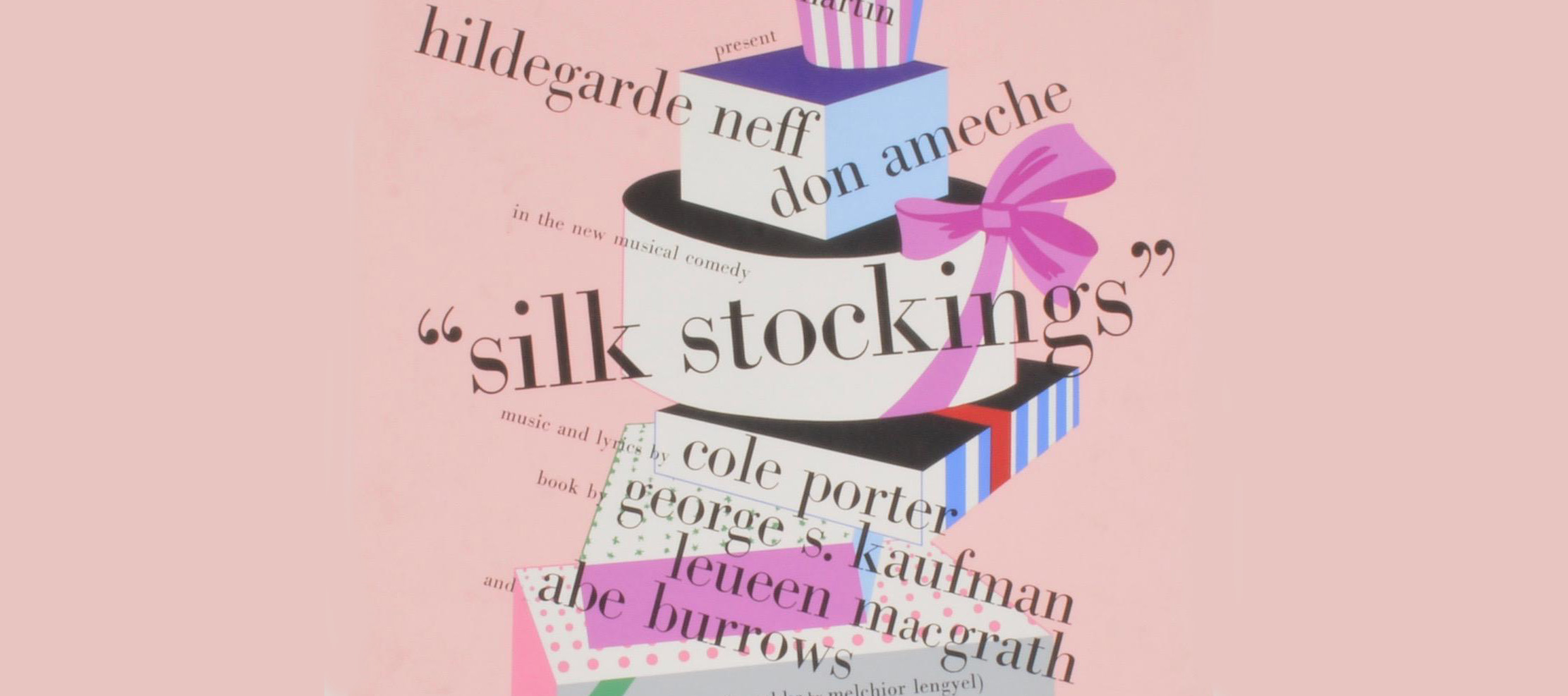
Musical
Musique: Cole Porter • Paroles: Cole Porter • Livret: Abe Burrows • George S. Kaufman • Laureen MacGrath • Production originale: 2 versions mentionnées
Dispo: Résumé Liste chansons
Silk Stockings est un musical avec un livret de George S. Kaufman, Leueen MacGrath et Abe Burrows et une musique et des paroles de Cole Porter. Le musical est vaguement basé sur l'histoire de Melchior Lengyel, Ninotchka, et l'adaptation cinématographique qu'elle a inspirée en 1939. Il a été diffusé à Broadway en 1955. Ce fut le dernier comédie musical que Porter a écrit pour la scène.
Résumé: Silk Stockings se déroule principalement à Paris, la ville de comédie musicale préférée de Cole Porter. Trois agents russes, Ivanov, Brankov et Bibinski sont envoyés là-bas pour récupérer le plus grand compositeur russe Peter Ilyich Boroff des voies détournées du capitalisme, mais bientôt les agents eux-mêmes sont enchantés par le mode de vie de l’Occident décadent. Quand Ninotchka reçoit l’ordre de Moscou de les ramener tous au pays, elle tombe elle aussi sous le charme de Paris et des bas de soie, et se retrouve amoureuse de l’agent de cinéma américain Steve Canfield, qui veut utiliser la musique de Boroff dans un futur film mettant en vedette Janice Dayton ancienne reine des films de "belles en maillot de abin" aux États-Unis qui veut maintenant passer à des films dramatiqueq avec une version musicale de Guerre et Paix. Inutile de dire que tout finit bien et que les agents russes ainsi que Boroff et Ninotchka se retrouvent du côté ouest du rideau de fer.
Principales versions:
1. Imperial Theatre (Broadway-Etats-Unis)
24/02/1955 14/04/1956
478 représ.
2. *** Film (***-***)
18/07/1957 //
représ.

Musical
Musique: Cole Porter • Paroles: Cole Porter • Livret: S.J. Perelman • Production originale: 2 versions mentionnées
Dispo: Commentaire Liste chansons
Aladdin est une fantaisie musicale de 1958 écrite spécialement pour la télévision, avec un livret de SJ Perelman et de la musique et des paroles de Cole Porter, diffusée en couleur dans l'émission DuPont Show of the Month par CBS. C'était la dernière partition musicale de Porter.
Principales versions:
1. *** TV (***-***)
21/02/1958 //
représ.
2. Coliseum Theatre (Londres-Angleterre)
17/12/1959 01/12/1960
145 représ.

Musical
Musique: Cole Porter • Paroles: Cole Porter • Livret: Alan Strachan • Benny Green • Production originale: 1 version mentionnée
Dispo: Résumé Liste chansons
Un musical sur le roi des musicals, Cole Porter. Benny Green et Alan Strachan ont intelligemment assemblé la plupart des tubes de Cole Porter dans une narration qui raconte l’histoire de sa vie, de Yale à Paris, à Manhattan, à Broadway, à Hollywood et, finalement, son retour à Broadway.
Résumé: Le musical comprend des standards de Porter tels que « I Love Paris », « Take Me Back to Manhattan », « Love for Sale », « Night and Day » et « I Get a Kick Out of You ».
Principales versions:
1. Mermaid Theatre (Londres-Angleterre)
02/07/1974 //
représ.
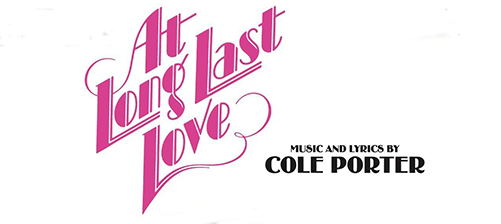
Film
Musique: Cole Porter • Paroles: *** Divers • Livret: Peter Bogdanovich • Production originale: 1 version mentionnée
Dispo: Résumé Génèse
At Long Last Love is a 1975 American jukebox musical comedy film written, produced, and directed by Peter Bogdanovich. It stars Burt Reynolds, Cybill Shepherd, Madeline Kahn, and Duilio Del Prete as two couples who each switch partners during a party and attempt to make each other jealous. Featuring 18 songs with music and lyrics by Cole Porter, Bogdanovich was inspired to make a musical with the composer's songs after Shepherd gave him a book of his songs. All of the musical sequences were performed live by the cast, since At Long Last Love was meant by Bogdanovich to be a tribute to 1930s musical films like One Hour With You, The Love Parade, The Merry Widow and The Smiling Lieutenant that also filmed the songs in the same manner.
Genèse: Production
At Long Last Love was Bogdanovich's first musical film, as well as the first motion picture he wrote by himself. He got the idea to a musical film of Cole Porter songs when his then-girlfriend Cybill Shepherd gave him a book of songs by the composer. "His lyrics conveyed a frivolous era," said the director. "With a kind of sadness, but very subtle... Cole Porter lyrics are less sentimental than, say, Gershwin and more abrasive... Gershwin was the greater musician. But Cole was a better lyricist and I was more interested in lyrics than music." When he heard the lyrics for "I Loved Him", with its reversal of emotion and wry lyric, he decided to use that as the finale and "worked back from there". The film was originally called Quadrille, and was equally weighted between the four lead characters.
In September 1973, Bogadanovich announced the cast would be Cybill Shepherd, Madeline Kahn, Ryan O'Neal, and the director himself.[8] Shepherd had recorded an album of Cole Porter songs paid for by Paramount called Cybill Does It... to Cole Porter. By March 1974, Bogdanovich had decided to not act, and replaced himself with Elliott Gould, who had experience in musical theatre. Gould and O'Neal dropped out. By March 1974 Burt Reynolds had replaced Gould. Bogdanovich says he was "talked into" using Burt Reynolds, who wanted to try a musical. "The whole joke that he's kind of a nice fellow, good looking, not particularly good at dancing. He can't dally with the girl. He's rather ineffectual." He gave the other male lead to Duilio Del Prete who had just been in Bogdanovich's Daisy Miller and who the director thought was going to be a big star. In March 1974, Fox agreed to finance the film.
Filming started August 1974. Resisting the urge to shoot another film in black and white, Bogdanovich had it art-directed as "Black and White in Color". He wanted the characters to feel like they were having a conversation using "greeting cards in the form of songs" like "they didn't know what to say to each other." The movies of Ernst Lubitsch with Jeanette MacDonald and Maurice Chevalier such as One Hour With You, The Love Parade, The Merry Widow and The Smiling Lieutenant influenced Bogdanovich to have all of the song sequences be filmed live, as it would recreate the "kind of sad, funny, melancholy, silly," and "spontaneous" vibe of the films. However, all of the lead actors, especially Reynolds "weren't accomplished singers or dancers," resulting in a lot of delays and mess-ups during the shooting process. In addition, the cast had a tough time performing the sequences due to having to perform them in one take and deal with wonky receiver systems in order to listen to the instrumentals. Bogdanovich later said he "was very arrogant" during the making of the film, "but that arrogance was bought out of a frantic insecurity. I knew it was so possible I was wrong that I became tough about insisting that I was right."
Versions
The studio rushed the film into release, with only two previews in San Jose (which Bogadanovich recalled being "a total disaster") and Denver. Bogdanovich made more changes to the film to have it be more focused on Reynolds' character due to pressure from the studio, and the final version was never previewed. Following a premiere at 20th Century-Fox Studios in Los Angeles on March 1, 1975, the film opened March 6 at Radio City Music Hall to scathing reviews and poor box office returns. The chorus of critical attacks prompted Bogdanovich to have an open letter of apology printed in newspapers throughout the U.S. Bogdanovich later said once the film was released "I realized how I should have cut it after that and I immediately did cut it, they let me recut and I think I paid for that, and that version was then shown on television and that's the version that all release prints have been ever since. That was quite different from the opening version. Very different, but unfortunately it was too late." The director has stated many people who first saw it in this version did not react so badly to the film.
Résumé: Four socialites unexpectedly clash: heiress Brooke Carter runs into the Italian gambler Johnny Spanish at the race track while playboy Michael O. Pritchard nearly runs into stage star Kitty O'Kelly with his car. Backstage at Kitty's show, it turns out she and Brooke are old friends who attended public school together. The foursome do the town, accompanied by Brooke's companion Elizabeth, who throws herself at Michael's butler and chauffeur Rodney James.
The four friends change partners at a party, where Brooke and Michael step outside behind Kitty and Johnny. In an effort to make the others jealous, Kitty, Johnny, Brooke, Michael, Elizabeth and Rodney begin their romance.
Principales versions:
1. *** Film (***-***)
01/03/1975 //
représ.
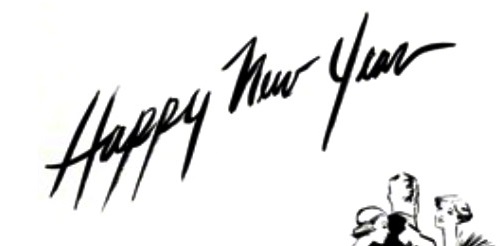
Musical
Musique: Cole Porter • Paroles: Cole Porter • Livret: Burt Shevelove • Production originale: 1 version mentionnée
Dispo: Résumé Génèse Liste chansons
Genèse: Porter successfully had transformed Barry's The Philadelphia Story into the musical film High Society, so Shevelove pored through the composer's catalogue in search of tunes that would fit Holiday's plot. When the show previewed at the Stratford Festival in Canada, the score consisted of lesser-known Porter songs, and Shevelove decided to eliminate most of them in favor of music more familiar to audiences. He also opted to replace much of Barry's original repartee with songs that suited neither the characters nor the situations, and replaced the gaps with a narrator whose purpose was to explain what was missing from the plot, a device that ultimately proved to be clumsy and confusing.
Résumé: The Narrator introduces the Seton family, who in December 1933 live in a five story townhouse on Fifth Avenue in New York City. He relates their story.
Successful Wall Street lawyer Johnny Case has become engaged to Julia Seton. Julia and her sister Linda celebrate the engagement ("At Long Last Love"). However, Johnny has decided to abandon his well-paid career and instead live a life of pleasure, using Julia's money. Julia's banker father Edward is very upset and her willful sister Linda is fascinated. Johnny begins to realize that he loves the unconventional Linda, and they become a couple, disregarding the "old money and values" of others for a life together.
Principales versions:
1. Morosco Theatre (Broadway-Etats-Unis)
04/04/1980 10/05/1980
25 représ.
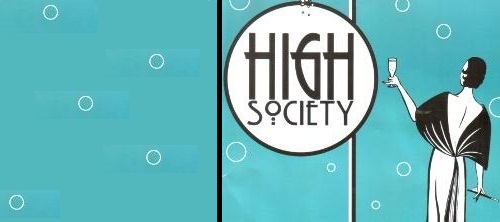
Musical
Musique: Cole Porter • Paroles: Cole Porter • Susan Birkenhead • Livret: Arthur Kopit • Production originale: 8 versions mentionnées
Dispo: Résumé Génèse Liste chansons
Genèse: Broadway
The musical had a try-out in San Francisco in 1997.
The musical premiered on Broadway at the St. James Theatre on April 27, 1998 and closed on August 30, 1998 after 144 performances and 27 previews. Directed by Christopher Renshaw, the cast included Stephen Bogardus (Macaulay Conner), Melissa Errico (Tracy), Daniel McDonald (Dexter), John McMartin (Uncle Willie), Randy Graff, Lisa Banes, Marc Kudisch, Betsy Joslyn and a 12-year-old Anna Kendrick. Sets were by Loy Arcenas, costumes were by Jane Greenwood, and lighting was by Howell Binkley. Des McAnuff was "brought in during the show's troubled tryout period" and is uncredited. Lar Lubovitch is credited as the choreographer, with Wayne Cilento uncredited
Ben Brantley, in his review for The New York Times, wrote: "...spirits are definitely high in 'High Society,' which stars a sadly misused Melissa Errico, but they also feel forced and even desperate. The show, first seen in a tepidly received version in San Francisco, has since undergone drastic retailoring. And it ominously shed its director and choreographer of record, Christopher Renshaw and Lar Lubovitch, during New York rehearsals, with Des McAnuff and Wayne Cilento stepping in to make last-minute revisions. Perhaps that accounts for the feverish, at-sea quality that seems to possess the show's team of talented, proven performers. The production's guiding rule appears to be to do whatever is necessary to land a joke or to sell a song... Numbers that should bubble with dry effervescence are more likely to come across as a thick ferment of suds."
London
A rather more successful West End production opened at the Victoria Palace Theatre on February 25, 1987 and ran for 420 performances. It starred Trevor Eve (Dexter), Stephen Rea (Mike), Angela Richards (Liz), Natasha Richardson (Tracy) and Ronald Fraser (Uncle Willie); the director was Richard Eyre.
On October 1, 2005, a West End revival starring Katherine Kingsley (Tracy Lord), Graham Bickley (Dexter Haven), Paul Robinson (Mike) and Jerry Hall (Mrs. Lord) opened at the Shaftesbury Theatre. This was based on the 2003 Open Air Theatre, Regent's Park production and subsequent tour. These productions were directed by Ian Talbot OBE. Tracie Bennett played Liz in the Open Air Theatre production and stole the show, according to The Guardian critic.
Résumé: Based on the Philip Barry play The Philadelphia Story and the musical screen adaptation it inspired, High Society, the plot centers on pretentious Long Island socialite Tracy Lord, who is planning a June 1938 wedding to an equally pretentious executive when ex-husband Dexter Haven arrives to disrupt the proceedings. Additional comic complications arise when tabloid reporter Mike Connor, who is there to cover the wedding, also falls for the bride-to-be.
Principales versions:
1. Victoria Palace Theatre (Londres-Angleterre)
// 16/01/1988
420 représ.
2. St. James Theatre (Broadway-Etats-Unis)
31/03/1998 30/08/1998
144 représ.
3. Metropol Theater (Vienne-Autriche)
03/06/1998 01/08/1998
représ.
4. Open Air Theatre, Regent's Park (Londres-Angleterre)
22/07/2003 13/09/2003
représ.
5. Shaftesbury Theatre (Londres-Angleterre)
01/10/2005 21/01/2006
120 représ.
6. UK Tour (-Angleterre)
// 04/08/2007
représ.
7. Upstairs at the Gatehouse (Londres-Angleterre)
18/12/2009 31/01/2010
représ.
8. Baden-Baden Stadttheater (Baden-Baden-Allemagne)
// 18/12/2010
représ.
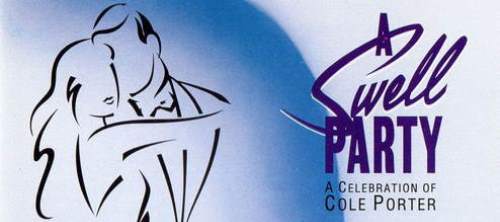
Musical
Musique: Cole Porter • Paroles: Cole Porter • Livret: John Kane • Production originale: 1 version mentionnée
Dispo: Résumé Synopsis
Résumé: “A Swell Party” started life in London in 1991 at the Vaudeville Theatre with Angela Richards, David Kerman, Anne Wood and Martin Smith. Nickolas Grace, the only man alive who actually looks like Cole Porter, played the composer-lyricist. Here it is now Simon Green, who is tall and looks nothing like Cole, who plays the Porter part, narrating the life and times of one of the twentieth-century’s greatest and most prolific songwriters who stands beside Irving Berlin, George & Ira Gershwin, Jerome Kern, Richard Rodgers & Lorenz Hart as the best that the Great American Songbook had to offer in the glorious heyday of popular song and music-theatre, the period from the mid-1920s to the early 1950s.
Principales versions:
1. Vaudeville Theatre (Londres-Angleterre)
// 28/03/1992
représ.


.png)
.png)




